The finest digital organs require superiority in all areas of sound production: sampling technology, sampling experience, acoustical enhancement, and voicing capabilities. Allen Organ Company is the leader in each area, the combination of which results in Allen Organs sounding better.

ALLEN ORGANS SOUND BETTER
Superior organ sound comes from a combination of advanced technology and years of artistic experience sampling pipe organs. Throughout history the organ has been a remarkable combination of technology and traditional music. With hundreds of pipes, early pipe organs were the most advanced products in a community. Modern electronics have enabled the production of pipe organ sound without requiring pipes. Today's finest digital instruments reproduce the grandeur of pipe organs, at significantly lower costs.
Allen's 7th-generation GENISYS™ Technology includes dozens of advanced Digital Signal Processors working in parallel, supercomputer power, offering the most realistic pipe organ sound available from a digital organ. Coupled with a two-decade lead in digital sampling experience over other digital organ builders, Allen Organ Company is the acknowledged leader!
Reproducing realistic pipe organ sound requires advanced technology. Allen's technology is proven weekly through its many combination organs that include both digital voices and windblown pipes played in the same building.
Proof statement: Listeners have difficulty determining the source of the sounds. A recent Allen combination organ installation in Stockholm, Sweden, is an example comparing, in real-time, Allen's digitally produced voices alongside of windblown pipes. Click to hear for yourself.

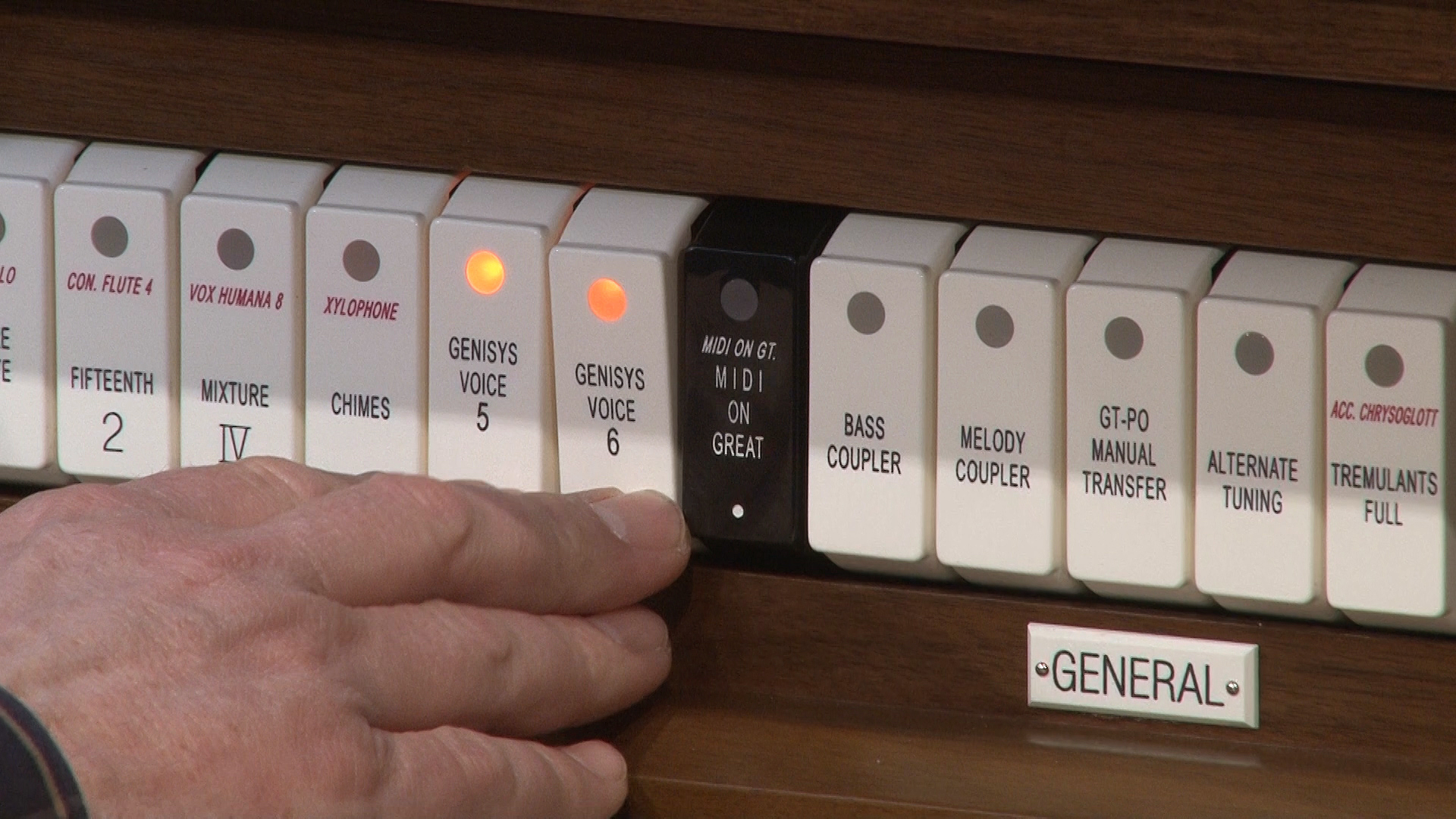
Today Allen's tonal capabilities go beyond traditional pipe organ sound. Allen Organs can also produce orchestral and other non-organ sounds to increase the instrument's flexibility. With GENISYS™ Voices technology, stops can be quickly be changed to dozens of orchestral sounds, as well as traditional organ voices not included in the instrument's standard specification. GENISYS Voices provides organists with the versatility needed for today's ever-changing musical landscape.
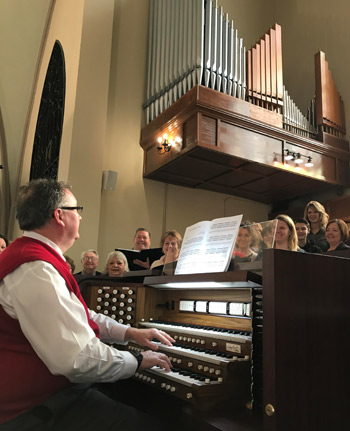
The success of any organ is highly dependent on the room's acoustics in which it is installed. Pipe organs were typically installed in large cathedral-like structures with "friendly" acoustics that include hard surfaces to reflect and acoustically mix the sounds produced. The importance of the room on an installation has led to the saying: "The most important 'stop' on any organ is the room in which it is placed." Modern churches typically do not offer this acoustical advantage.
In the latter part of the 20th century, in an effort to overcome this challenge, organ manufacturers added digital reverberation to instruments. While an improvement, digital reverb also added unnatural distortions to organ sound. Digital reverberation is no longer the state-of-the-art acoustical enhancement!
Convolution technology utilizes actual sampled acoustics to recreate the sonic fingerprint of rooms, including famous cathedrals. Convolution also reproduces the sonic interplay that occurs between individual pipes played within organ chambers.
Allen's exclusive Acoustic Portrait™ with convolution technology requires massive computing power, approximately 400 million calculations per second. Unlike artificial digital reverberation, Acoustic Portrait produces the real thing! This revolutionary technology allows an Allen Organ to perfectly integrate in a building, similar to that of world-renowned pipe organs in large cathedrals.


Advanced technology allows digital organs to include dozens of features to increase musical versatility.
Allen's GENISYS™ Display color touchscreen is elegantly designed to be simple, freeing organists to focus on the music, not complex technology.
The organ is the "King of Instruments" not only because of majestic sound, but also because of its incredible dynamic range. The organist interacts with the instrument via the organ console that serves as "command central". Early pipe organ consoles were limited to their keyboards, a pedalboard and stop controls. Even with these relatively limited controls, changing dozens of stops during a performance was daunting.
In the early 20th century capture combination action systems were added, making preset stop combinations available and freeing up organists to create more expressive music. Since then organ builders have added more sophisticated user interface systems.
With the advent of digital technology, organs went through a revolution. Today's finest digital organs can duplicate the sound of pipe organs. Also, with increasing power, computer processors have enabled enhancements that expand the instrument's versatility, including more advanced capture combination systems, record and playback capabilities, the addition of orchestral and contemporary voices, multiple stop specifications, and more. However, the additional features increased the number of physical controls, adding complexity to performance. Utilizing these features required understanding huge owner's manuals and navigating multiple controls.
The challenges brought about by increased capabilities is not limited to just the organ. For example, automobiles now include GPS, Bluetooth, backup cameras, and sophisticated audio and climate control systems that required separate buttons and knobs which distracted drivers. Consumers demanded a better user interface system.
The answer: a color touch screen that has become the universal solution for high-tech products.
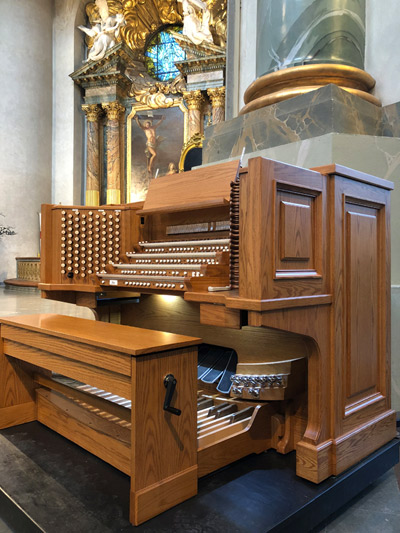

Until recently, all organ user interface systems were older technologies that included multiple button and controls. Making changes to organ functions required engaging multiple controls and memorizing menu levels. While most builders still offer this type of interface, Allen Organ Company has introduced a state-of-the-art system with a responsive color touchscreen. GENISYS™ Display is intuitive to the point that even guest organists not familiar with the instrument can easily access dozens of important console functions.
In a digital organ the most important task for advanced technology is to enable the production of realistic pipe organ sounds. Technology needs to also enhance the user experience so that organists can focus on creating music, not operating complex controls. A digital organ should today include not only technology that is superior in sound production, but also advanced technology for its human interface system to enhance the artistic experience.

In a world where the quality of most consumer products is similar, the difference between the quality of an Allen Organ and others is remarkable.
These differences prove that Allen Organs are built better. They help explain why Allen Organs last longer, offering the greatest value.
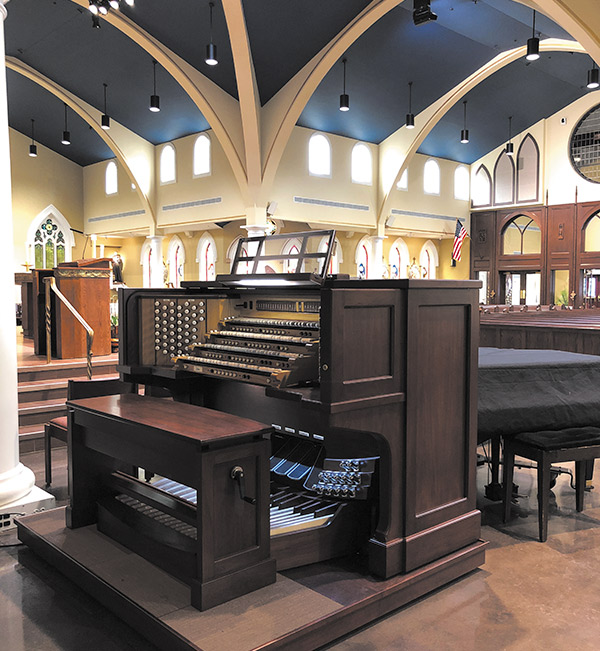
Quality plays a crucial role in product value. Unique for high-tech products, church organs are expected to last for decades, making build quality an even more important metric in determining the product's longevity potential.
Allen Organ Company's quality is legendary with instruments now in their seventh decade remaining in service. No other builder can match this record, a result of Allen's build quality and its willingness and ability to support products long after their production has ceased.
The quality built into a digital organ can be determined through simple observation of the product.

Viewed from the outside, most organ consoles are attractive. However, going "under the covers" and looking inside helps determine its actual quality.
Is the wood inside the console finished so that it will not absorb moisture and warp over time?
Are key wood components held together by wooden cleats, as in any furniture of quality?
Are openings into the console, such as the expression shoe cut out, protected by metal enclosures to keep rodents out that damage circuitry?
Shortcuts are unacceptable in any area.

Unusual for high-tech products that are typically included in metal enclosures, an organ console is constructed of wood. To protect electronic circuitry and to ensure that the organ meets strenuous governmental EMI (Electromagnetic Interference) requirements and safety requirements, electronic assemblies in organs should be housed in metal enclosures.
Some builders cut costs by eliminating this step in the hope that customers will not look inside the console.


PREMIUM KEYBOARDS
The Allen keyboard utilizes sealed contacts and wood keysticks to provide the ultimate in touch and control. The level of quality and adjustability of Allen keyboards makes them the envy of the industry and the choice of discerning musicians.
KEY CONTACT
The key contact, while unseen, is an important part of any church organ. If one fails during a performance, the entire musical program can be compromised. Allen introduced a maintenance-free system in which a sealed reed switch is engaged by magnet. Neither dust nor the environment will compromise your music program with an Allen Organ.


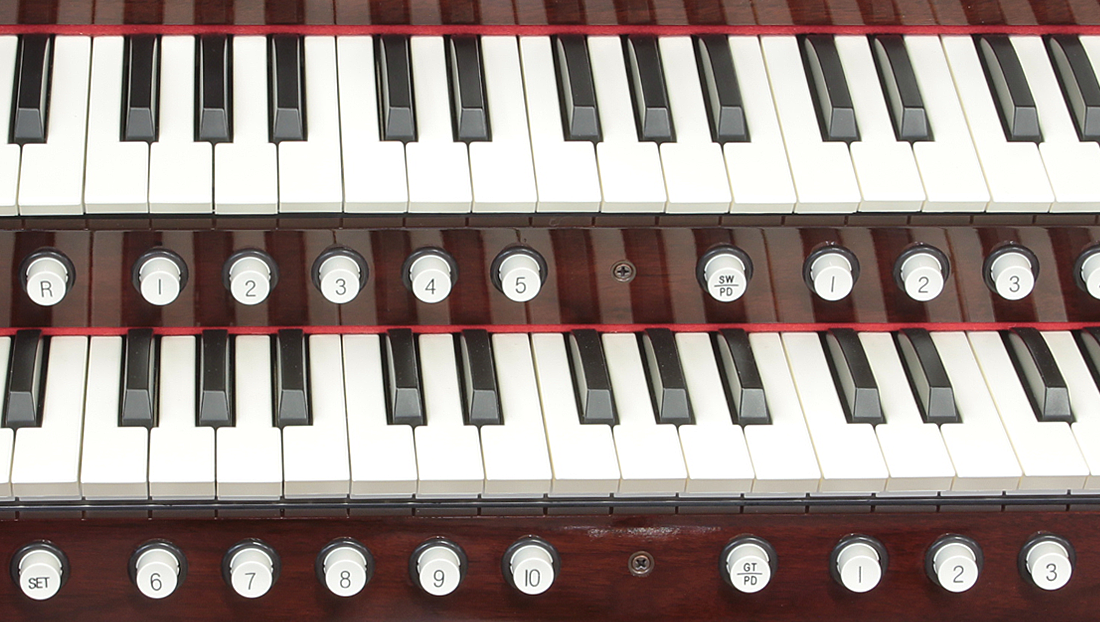
PREMIUM KEYBOARDS
The Allen keyboard utilizes sealed contacts and wood keysticks to provide the ultimate in touch and control. The level of quality and adjustability of Allen keyboards makes them the envy of the industry and the choice of discerning musicians.
KEY CONTACT
The key contact, while unseen, is an important part of any church organ. If one fails during a performance, the entire musical program can be compromised. Allen introduced a maintenance-free system in which a sealed reed switch is engaged by magnet. Neither dust nor the environment will compromise your music program with an Allen Organ.


TO-5X SPECIFICATIONS
Featuring Four Stop List Scaling/Voicing Capability
PEDAL
32 Contra Diaphone
32 Contra Tibia S
32 Contra Violone
16 Double English Horn
16 Bombarde
16 Ophicleide
16 Diaphone
16 Diaphonic Horn
16 Tibia Clausa S
16 Tibia Clausa M
16 Clarinet
16 Bass String (2 rks)
16 Oboe Horn
16 Violone
16 Bourdon
16 Dulciana (2 rks)
8 English Horn
8 Tuba Mirabilis
8 Tuba Horn
8 Diaphonic Diapason
8 Open Diapason
8 Horn Diapason
8 Tibia Clausa
8 Tibia Clausa
8 Tibia Clausa
8 Tibia Clausa PIZZ
8 Clarinet
8 Major Strings (4 rks)
8 Minor Strings (6 rks)
8 French Horn
8 Oboe Horn
8 Concert Flute
16 Piano
8 Piano
Bass Drum
Tympani
Crash Cymbal
Tap Cymbal
Brush Cymbal
Finger Cymbals
Triangle
Accomp to Pedal
Great to Pedal
Great Octave Pedal
Solo on Pedal
MIDI on Pedal
Accomp Traps to Pedal
ACCOMPANIMENT
8 English Horn
8 Tuba Mirabilis
8 Solo Trumpet
8 Chorus Trumpet
8 Tuba Horn
8 Diaphonic Diapason
8 Open Diapason
8 Horn Diapason
8 Tibia Clausa S
8 Tibia Clausa M
8 Clarinet
8 Solo String (2 rks)
8 Gamba (2 rks)
8 Cello (2 rks)
8 Viol d'Orchestre (2 rks)
8 Salicional (2 rks)
8 French Horn
8 Oboe Horn
8 Quintadena
8 Lieblich Flute
8 Concert Flute
8 Spitz Flute (2 rks)
8 Vox Humana
8 Vox Humana
8 Dulciana (2 rks)
4 Octave Open
4 Octave Horn
4 Piccolo M
4 Solo String (2 rks)
4 Gambette (2 rks)
4 Cello (2 rks)
4 Viol (2 rks)
4 Salicet (2 rks)
4 Lieblich Flute
4 Concert Flute
4 Spitz Flute (2 rks)
4 Vox Humana
4 Vox Humana
4 Dulcet (2 rks)
2 2/3 Lieblich Twelfth
2 2/3 Twelfth
2 Lieblich Piccolo
2 Piccolo
8 Piano
Wood Harp Sub
Wood Harp
Metal Harp
Chrysoglott
Snare Drum
Castanets
Tambourine
Wood Block
Tom-Tom
Hi Hat
Tap Cymbal
Brush Cymbal
Octave
Solo to Accomp
MIDI on Accomp
GREAT
16 Double English Horn
16 Bombarde
16 Solo Trumpet (Ten C)
16 Chorus Trumpet (Ten C)
16 Ophicleide
16 Diaphone
16 Open Diapason (Ten C)
16 Diaphonic Horn
16 Tibia Clausa
16 Tibia Clausa (Ten C)
16 Tibia Clausa
16 Clarinet
16 Orchestral Oboe (Ten C)
16 Musette (Ten C)
16 Saxophone (Ten C)
16 Solo String (2 rks)
16 Gamba (2 rks)
16 Cello (2 rks)
16 Minor Strings (4 rks)
16 Krumet (Ten C)
16 Cor Anglais (Ten C)
16 Oboe Horn
16 Quintadena (Ten C)
16 Bourdon
16 Vox Humana (Ten C)
16 Vox Humana (Ten C)
16 Dulciana (2 rks)
8 English Horn
8 Tuba Mirabilis
8 Solo Trumpet
8 Chorus Trumpet
8 Tuba Horn
8 Diaphonic Diapason
8 Open Diapason
8 Horn Diapason
8 Tibia Clausa
8 Tibia Clausa
8 Tibia Clausa
8 Clarinet
8 Kinura
8 Orchestral Oboe
8 Musette
8 Saxophone
8 Solo String (2 rks)
8 Gamba (2 rks)
8 Cello (2 rks)
8 Viol d'Orchestre (2 rks)
8 Salicional (2 rrks)
8 Krumet
8 Cor Anglais
8 French Horn
8 Oboe Horn
8 Quintadena
8 Lieblich Flute
8 Concert Flute
8 Spitz Flute (2 rks)
8 Vox Humana
8 Vox Humana
8 Dulciana (2 rks)
5 1/3 Fifth (Tibia S)
5 1/3 Fifth (Tibia M)
4 Octave
4 Octave Open
4 Octave Horn
4 Piccolo
4 Piccolo
4 Piccolo
4 Solo String (2 rks)
4 Gambette (2 rks)
4 Cello (2 rks)
4 Viol (2 rks)
4 Salicet (2 rks)
4 Harmonic Flute
4 Lieblich Flute
4 Spitz Flute (2 rks)
4 Dulcet (2 rks)
3 1/5 Tenth (Tibia M)
2 2/3 Twelfth (Tibia S)
2 2/3 Twelfth (Tibia M)
2 2/3 Lieblich Twelfth
2 Piccolo (Tibia)
2 Piccolo (Tibia)
2 Piccolo (Tibia)
2 Fifteenth
2 Lieblich Piccolo
1 3/5 Lieblich Tierce
1 Lieblich Fife
8 Piano
4 Piano
Wood Harp Sub
Wood Harp
Xylophone Sub
Xylophone
Glockenspiel
Chrysoglott
Sub Octave
Unison Off
Octave
Solo on Great
MIDI on Great
ORCHESTRAL
16 Double English Horn
16 Solo Trumpet (Ten C)
16 Ophicleide
16 Tibia Clausa
16 Tibia Clausa (Ten C)
16 Tibia Clausa
16 Saxophone (Ten C)
16 Major Strings (4 rks)
16 Minor Strings (6 rks)
16 Vox Humana (Ten C)
16 Vox Humana (Ten C)
8 English Horn
8 Tuba Mirabilis
8 Solo Trumpet
8 Chorus Trumpet
8 Style D Trumpet
8 Tuba Horn
8 Open Diapason
8 Horn Diapason
8 Tibia Clausa
8 Tibia Clausa
8 Tibia Clausa
8 Clarinet
8 Orchestral Oboe
8 Musette
8 Saxophone
8 Solo String (2 rks)
8 Gamba (2 rks)
8 Cello (2 rks)
8 Minor Strings (4 rks)
8 Krumet
8 Cor Anglais
8 French Horn
8 Vox Humana
8 Vox Humana
4 Piccolo
4 Piccolo
4 Piccolo
4 Solo String (2 rks)
4 Mezzo Strings (4 rks)
4 Minor Strings (4 rks)
4 Harmonic Flute
2 2/3 Twelfth (Tibia S)
2 2/3 Twelfth (Tibia M)
2 Piccolo (Tibia S)
2 Piccolo (Tibia M)
1 3/5 Tierce (Tibia M)
8 Piano
Wood Harp
Xylophone
Glockenspiel
Metal Harp
Vibraharp
Chrysoglott
Sub Octave
Unison Off
Octave
Solo on Orch
MIDI on Orch
ANCILLARY
8 Principal
4 Octave
2 Superoctave
Mixture IV
8 Fanfare Trumpet
BOMBARDE
16 Double English Horn
8 English Horn
8 Tuba Mirabilis
8 Solo Trumpet
8 Chorus Trumpet
8 Style D Trumpet
8 Tuba Horn
8 Diaphonic Diapason
8 Open Diapason
8 Tibia Clausa
8 Tibia Clausa
8 Tibia Clausa
8 Saxophone
8 Major Strings (4 rks)
8 Minor Strings (6 rks)
8 Vox Humana
8 Vox Humana
4 Piccolo
4 Piccolo
4 Piccolo
4 Major Strings (4 rks)
4 Minor Strings (6 rks)
2 2/3 Twelfth (Tibia S)
2 2/3 Twelfth (Tibia M)
2 Piccolo (Tibia)
2 Piccolo (Tibia)
2 Piccolo (Tibia)
1 Fife (Tibia M)
8 Piano
Xylophone
Glockenspiel
Vibraharp
Chrysoglott
Sub Octave
Unison Off
Octave
Great to Bombarde
Great Octave Bombarde
Orch to Bombarde
Solo on Bombarde
MIDI on Bombarde
SOLO
8 Fanfare Trumpet
8 English Horn
8 Tuba Mirabilis
8 Solo Trumpet
8 Chorus Trumpet
8 Style D Trumpet
8 Tuba Horn
8 Diaphonic Diapason
8 Open Diapason
8 Tibia Clausa
8 Tibia Clausa
8 Tibia Clausa
8 Clarinet
8 Kinura
8 Orchestral Oboe
8 Musette
8 Saxophone
8 Major Strings (4 rks)
8 Minor Strings (6 rks)
8 Krumet
8 Cor Anglais
8 French Horn
8 Oboe Horn
8 Vox Humana
8 Vox Humana
8 Piccolo
4 Piccolo
4 Piccolo
4 Harmonic Flute
2 2/3 Twelfth (Tibia S)
2 2/3 Twelfth (Tibia M)
2 Piccolo (Tibia)
2 Piccolo (Tibia)
2 Piccolo (Tibia)
1 3/5 Tierce (Tibia S)
1 3/5 Tierce (Tibia M)
1 1/3 Larigot (Tibia M)
Sub Octave
Unison Off
Octave
MIDI on Solo
8 Piano
Wood Harp Sub
Xylophone
Glockenspiel
Metal Harp
Vibraharp
Cathedral Chimes
ACCOMP 2nd Touch
8 English Horn
8 Tuba Mirabilis
8 Solo Trumpet
8 Chorus Trumpet
8 Tuba Horn
8 Diaphonic Diapason
8 Tibia Clausa S
8 Tibia Clausa M
8 Clarinet
8 French Horn
4 Piccolo (2 rks)
Glockenspiel Octave
Cathedral Chimes
Percussions 2nd Touch
Traps 2nd Touch
Great Octave Accomp
Solo on Accomp
MIDI on Accomp
GREAT 2nd Touch
English Horn 16-8
Solo on Great
Solo on Great PIZZ
MIDI on Great
TREMULANTS
Main
Main Strings
Clarinet
Tibias/Sax/Voxes
Solo
Solo Strings
Tubas
Trumpets
English Horn
KEY CHEEK PISTONS
Unisons Off
Celestes Off
Main Vox 1 Off
Main Vox 2 On
Solo Vox 1 Off
Solo Vox 2 On
Chorus Trumpet Off
Style D Trumpet On
Quintadena Celeste
Horn Diapason Celeste
Master Expression
Marimba Re-it
Chrysoglott Motor
Vibraharp Motor
Ancillary on Solo
Ancillary on Orch
Ancillary on Bombarde
Ancillary on Great
Ancillary on Accomp
Ancillary on Pedal
TOE PISTON EFFECTS
Persian Cymbal
Gong
Wind Chimes
Train
Birds
CHAMBER ANALYSIS
MAIN
1 Chorus Trumpet 8
2 Tuba Horn 16-4
3 "D" Trumpet 8
4 Diaphonic Diapason 32-4
5 Open Diapason 8-4
6 Tibia Clausa 16-2
7 Clarinet 16-8
8 Musette 8
9 Cor Anglais 8
10 Gamba 8-4
11 Gamba Celeste 8-4
12 Viol d'Orchestra 8-2
13 Viol Celeste 8-4
14 Salicional 8-2
15 Salicional Celeste 8-4
16 Oboe Horn 16-8
17 Harmonic Flute 4
18 Concert Flute 16-4
19 Dulciana 16-4
20 Dulciana Celeste 16-4
21 Vox Humana 8-4
22 Vox Humana #2 8-4
23 Violone (Pedal) 32-16
Chrysoglott
SOLO
32 English Posthorn 16-8
33 Tuba Mirabilis 16-8
34 Brass Trumpet 8
35 Horn Diapason/Diaphone 16-4
36 Horn Diapason Celeste 8-4
37 Tibia Clausa 32-2
38 Brass Saxophone 8
39 Orchestral Oboe 8
40 Kinura 8
41 Krumet 8
42 Solo String 16-4
43 Solo String Celeste 8-4
44 Cello 8-4
45 Cello Celeste 8-4
46 French Horn 8
47 Quintadena 8
48 Quintadena Celeste 8
49 Lieblich Flute 8-2
50-51 Spitzflute Celeste II 8-4
52 Vox Humana 8-4
53 Vox Humana #2 8-4
ANCILLARY
24 Principal 8
25 Octave 4
26 Superoctave 2
27-30 Mixture IV
31 Trompette en-chamade 8
PERCUSSION
54 Tibia Clausa 8-2
55 8' Pedal Tibia Pizzicato
Piano
Wood Harp
Wood Harp Re-it
Metal Harp
Vibraharp
Xylophone
Glockenspiel
Chimes
TRAPS
Bass Drum
Tympani
Crash Cymbal
Tap Cymbal
Brush Cymbal
Finger Cymbals
Choke Cymbal
Wood Block
Tambourine
Castanets
Tom-tom
Snare Drum
SOUND EFFECTS
Persian Cymbal
Train
Wind Chimes
Birds
Gong

ALLEN EXPRESSION / CRESCENDO PEDALS

EXPRESSION SHOE CAGE

PREMIUM KEYBOARDS
The Allen keyboard utilizes sealed contacts and wood keysticks to provide the ultimate in touch and control. The level of quality and adjustability of Allen keyboards makes them the envy of the industry and the choice of discerning musicians.
KEY CONTACT
The key contact, while unseen, is an important part of any church organ. If one fails during a performance, the entire musical program can be compromised. Allen introduced a maintenance-free system in which a sealed reed switch is engaged by magnet. Neither dust nor the environment will compromise your music program with an Allen Organ.



GENISYS™ Voices provide the tonal diversity of a comprehensive stop list to even the most modest instruments. GENISYS Voices set a new standard for organist-friendly operation and include sounds that enhance every style of worship and organ literature!
STR-4X SPECIFICATIONS
Featuring Two Complete Voicings
32 Theatre Ranks
Solo
Tuba Mirabilis
English Posthorn
Brass Trumpet
Horn Diapason
Horn Diapason Celeste
Solo Tibia Clausa
Kinura
Orchestral Oboe
Krumet
Saxophone
Solo String
Solo String Celeste
Quintadena
Lieblich Flute
Solo Vox Humana
Main
Tuba Horn
"D" Trumpet
Open Diapason
Main Tibia Clausa
Clarinet
Musette
Violin
Violin Celeste
Gamba
Gamba Celeste
Gemshorn
Gemshorn Celeste
Oboe Horn
Concert Flute
Main Vox Humana
Chrysoglott
Percussion
Pedal Pizz. Tibia Clausa
Morton Tibia Clausa
Piano
Glockenspiel
Xylophone
Wood Harp/Marimba
Vibraphone
Solo Chrysoglott
Chimes
Bass Drum
Snare Drum Roll
Tambourine
Castanets
Tom-Tom
Wood Block
Tap Cymbal
Brush Cymbal
Triangle
Choke Cymbal
Splash Cymbal
Persian (roll) Cymbal
Crash Cymbal
Tuned Tympani
Tympani Roll
Auto Horn
Birds
Gong
Siren
Wind Chimes
Train Whistle
STR-4X
Pedal
32 Contra Diaphone C. Bomb
32 Contra Tibia Clausa
16 Bombarde
16 Double English Horn
16 Ophicleide
16 Diaphone
16 Diaphonic Horn
16 Solo Tibia Clausa
16 Bass Clarinet
16 Contra Gamba 2 Rks
16 Oboe Horn
16 Bourdon
16 Gemshorn 2 Rks
8 Tuba Mirabilis
8 English Horn
8 Tuba Horn
8 Open Diapason
8 Horn Diapason
8 Solo Tibia Clausa
8 Tibia Clausa
8 Tibia Clausa Pizz.
8 Clarinet
8 Cello 2 Rks
8 Flute
Accomp. to Pedal
Great to Pedal
Solo to Pedal
MIDI on Pedal
16 Piano Open Diap.
Bass Drum
Tympani
Crash Cymbal Mixture III
Tap Cymbal
Brush Cymbal
Sound Effects
Splash Cymbal
Wind Chimes
Gong
Birds
Auto Horn
Siren
Train Whistle
Accompaniment
8 Tuba Mirabilis
8 English Horn
8 Trumpet
8 Style D Trumpet
8 Tuba Horn
8 Open Diapason
8 Horn Diapason
8 Solo Tibia Clausa
8 Tibia Clausa
8 Clarinet
8 Solo Sting 2 Rks
8 Violin 2 Rks
8 Gamba 2 Rks
8 Oboe Horn
8 Quintadena
8 Lieblich Flute
8 Concert Flute
8 Vox Humana (S)
8 Vox Humana
4 Octave
4 Octave Horn
4 Piccolo
4 Solo String 2 Rks
4 Viol 2 Rks
4 Gambette 2 Rks
4 Lieblich Flute
4 Concert Flute
4 Vox Humana (M)
2 2/3 Twelfth
2 Piccolo
Octave
Solo on Accomp. Bombarde
MIDI on Accomp.
8 Piano Open Diap.
Harp Sub Mixture IV
Harp Scharf IV
Solo Chrysoglott
Chrysoglott Mixture III
Snare Drum
Castanets
Tambourine
Wood Block
Tom-Tom
Choke Cymbal
Tap Cymbal
Brush Cymbal
Triangle
Accomp. 2nd Touch
8 Tuba Mirabilis
8 English Horn
8 Trumpet
8 Style D Trumpet
8 Tuba Horn
8 Open Diapason
8 Solo Tibia Clausa
8 Clarinet
4 Piccolos
Octave Glockenspiel
Octave 4
Cathedral Chimes
Perc Second Touch
Traps Second Touch
Great Octave to Accomp.
Solo to Accomp.
MIDI on Accomp. 2nd
Solo
8 Tuba Mirabilis
8 English Horn
8 Trumpet
8 Style D Trumpet
8 Tuba Horn
8 Open Diapason
8 Horn Diapason
8 Solo Tibia Clausa
8 Tibia Clausa
8 Clarinet
8 Kinura Clarion 4
8 Orchestral Oboe
8 Musette French Horn
8 Krumet
8 Saxophone
8 Solo String 2 Rks
8 Violin 2 Rks
8 Gamba 2 Rks
8 Quintadena
8 Lieblich Flute
8 Vox Humana (S)
8 Vox Humana
4 Solo Piccolo
4 Piccolo
2 2/3 Solo Twelfth
2 Solo Piccolo
2 Piccolo
1 3/5 Solo Tierce
1 1/3 Solo Larigot
Sub Octave
Unison Off
Octave
6 2/5 Solo Third
5 1/3 Solo Fifth
MIDI on Solo
8 Piano Open Diap.
Glockenspiel Octave 4
Xylophone Fifteenth 2
Harp Sub Mixture IV
Vibraharp Plein Jeu IV
Chrysoglott Sub Mixture III
Cathedral Chimes
Great
16 Bombarde
16 Double English Horn
16 Trumpet (Ten C)
16 Ophicleide
16 Diaphone
16 Diaphonic Horn
16 Solo Tibia Clausa
16 Tibia Clausa (Ten C)
16 Clarinet
16 Orchestral Oboe (Ten C)
16 Musette (Ten C) French Horn
16 Krumet (Ten C)
16 Saxophone (Ten C)
16 Solo String 2 Rks
16 Violin 2 Rks
16 Gamba 2 Rks
16 Oboe Horn
16 Bourdon
16 Vox Humana (S) (Ten C)
16 Vox Humana (Ten C)
8 Tuba Mirabilis
8 English Horn
8 Trumpet
8 Tuba Horn
8 Open Diapason
8 Horn Diapason
8 Solo Tibia Clausa
8 Tibia Clausa
8 Clarinet
8 Kinura Clarion 4
8 Orchestral Oboe
8 Musette French Horn
8 Krumet
8 Saxophone
8 Solo String 2 Rks
8 Violin 2 Rks
8 Gamba 2 Rks
8 Oboe Horn
8 Quintadena
8 Lieblich Flute
8 Concert Flute
8 Vox Humana (S)
8 Vox Humana
5 1/3 Fifth (Tibia)
4 Octave
4 Octave (Horn)
4 Solo Piccolo
4 Piccolo
4 Solo String 2 Rks
4 Viol 2 Rks
4 Gambette 2 Rks
4 Lieblich Flute
4 Concert Flute
3 1/5 Lieblich Tenth Plein Jeu IV
2 2/3 Solo Twelfth
2 2/3 Twelfth
2 Solo Piccolo
2 Piccolo
2 Fifteenth
2 Piccolo
1 Fife (Lieb)
Sub Octave
Unison Off
Octave
Solo on Great
MIDI on Great
8 Piano Open Diap.
Glockenspiel Octave 4
Xylophone Fifteenth 2
Harp Mixture IV
Chrysoglott Mixture III
Great 2nd Touch
16 Double English Horn
8 English Horn
Solo on Great
Solo on Great Pizz.
MIDI on Great 2nd
Bombarde
16 Bombarde
16 Double English Horn
16 Trumpet (Ten C)
16 Ophicleide
16 Diaphone
16 Solo Tibia Clausa
16 Tibia Clausa (Ten C)
16 Krumet (Ten C)
16 Saxophone (Ten C) Clarion 4
16 String Ensemble 6 Rks
16 Vox Humana (S) (Ten C)
16 Vox Humana (Ten C)
8 Tuba Mirabilis
8 English Horn
8 Trumpet
8 Tuba Horn
8 Open Diapason
8 Solo Tibia Clausa
8 Tibia Clausa
8 Krumet
8 Saxophone
8 Solo String 2 Rks
8 Violin 2 Rks
8 Gamba 2 Rks
8 Vox Humana (S)
8 Vox Humana
4 Solo Piccolo
4 Piccolo
4 String Ensemble 6 Rks
2 2/3 Solo Twelfth
2 Solo Piccolo
2 Piccolo
Sub Octave
Octave
Great to Bombarde
Great Octave Bombarde
Solo on Bombarde
MIDI on Bombarde
8 Piano Open Diap.
Glockenspiel Octave 4
Xylophone Fifteenth 2
Harp Mixture IV
Solo Chrysoglott Plein Jeu IV
Chrysoglott Mixture III
Tremulants
Main
Main Strings
Clarinet
Solo
Solo Strings
Tibias
Voxes
Tuba Horn
Tuba Mirabilis
English Horn
Pistons
Great Solo Tibia Off
Great Morton Tibia On
Bombarde Solo Tibia Off
Bombarde Morton Tibia On
Acc./Solo/String>Gems
Great/Solo/String>Gems
So > Gt Melody Coupler
Horn Diapason Celeste On
Marimba Re-it
String Celeste Off
Great Tuba Horn Off
Great Style D Trumpet On
Bombarde Tuba Horn Off
Bombarde Style D Trumpet On
Percussion > Master Expression
Main > Master Expression
32 Contra Tibia (Toe Stud)

Walter Strony is one of America's premier concert organists. He has established himself as one of those few organists equally at home playing both theatre and classical organ.
Walt has performed hundreds of concerts worldwide, including many conventions of the American Theatre Organ Society and the American Guild of Organists. He has twice been voted "Organist of the Year" by the ATOS - the only living theatre organist to have received that honor. In 1999, he made his premiere appearance with the Calgary Philharmonic Orchestra.
Walt was inducted into the ATOS Hall of Fame and is also well known for his many fine recordings. His services as a pipe and digital organ consultant are always in demand in addition to his prowess as a concert artist.

ALLEN EXPRESSION / CRESCENDO PEDALS

EXPRESSION SHOE CAGE

GENISYS™ Voices provide the tonal diversity of a comprehensive stop list to even the most modest instruments. GENISYS Voices set a new standard for organist-friendly operation and include sounds that enhance every style of worship and organ literature!
TX323 SPECIFICATIONS
Featuring multiple organ Stop Lists: Morton, Wurlitzer, Barton
PEDAL
32 CONTRA VIOLONE
16 OPHICLEIDE
16 DIAPHONE
16 VIOLONE
16 BOURDON
8 ENGLISH POST HORN
8 TRUMPET
8 OPEN DIAPASON
8 SOLO TIBIA CLAUSA
8 TIBIA CLAUSA (PIZZ.)
8 CLARINET
8 FLUTE
16 PIANO
8 PIANO
ACCOMPANIMENT TO PEDAL
BASS DRUM
TAP CYMBAL (BRUSH)
GENISYS VOICE 1
GENISYS VOICE 2
ACCOMPANIMENT
8 ENGLISH POST HORN
8 BRASS TRUMPET
8 TUBA MIRABILIS
8 TRUMPET
8 OPEN DIAPASON
8 TIBIA CLAUSA (m)
8 CLARINET
8 VIOLINS 3 RKS
8 OBOE HORN
8 QUINTADENA
8 CONCERT FLUTE
8 VOX HUMANA
4 OCTAVE
4 PICCOLO (m)
4 CONCERT FLUTE
ACC VIOLINS>DOLCES
OCTAVE
8 PIANO
HARP SUB
HARP
CHRYSOGLOTT
SNARE DRUM
TOM-TOM (CASTANETS)
HI-HAT (TAMBOURINE)
TAP CYMBAL (BRUSH)
ALTERNATE TRAPS
TRAPS TO 2ND T
GENISYS VOICE 3
GENISYS VOICE 4
GREAT
16 ENGLISH POST HORN
16 BRASS TRUMPET (ten c)
16 BOMARDE
16 DIAPHONE
16 SOLO TIBIA CLAUSA (ten c)
16 TIBIA CLAUSA (ten c)
16 CLARINET
16 KRUMET (ten c)
16 ORCHESTRAL OBOE (ten c)
16 SAXAPHONE (ten c)
16 VIOLINS 3 RKS (ten c)
16 VOX HUMANA (ten c)
8 ENGLISH POST HORN
8 BRASS TRUMPET
8 TUBA MIRABILIS
8 TRUMPET
8 OPEN DIAPASON
8 SOLO TIBIA CLAUSA
8 TIBIA CLAUSA
8 CLARINET
8 KRUMET
8 ORCHESTRAL OBOE
8 SAXOPHONE
8 VIOLINS 3 RKS
8 QUINTADENA
8 CONCERT FLUTE
8 VOX HUMANA
5 1/3 FIFTH (TIBIA)
4 OCTAVE
4 SOLO PICCOLO
4 PICCOLO
4 VIOLINS 3 RKS
4 FLUTE
2 2/3 TWELFTH
2 SOLO PICCOLO
2 PICCOLO
2 FIFTEENTH
1 FIFE (FLUTE)
XYLOPHONE
GLOCKENSPIEL
SUB OCTAVE
OCTAVE
SOLO SUB GREAT
SOLO TO GREAT
GENISYS VOICE 5
GENISYS VOICE 6
SOLO
8 ENGLISH POST HORN
8 BRASS TRUMPET
8 TUBA MIRABILIS
8 TRUMPET
8 OPEN DIAPASON
8 SOLO TIBIA CLAUSA
8 TIBIA CLAUSA
8 CLARINET
8 KRUMET
8 ORCHESTRAL OBOE
8 SAXAPHONE
8 VIOLINS 3 RKS
8 CONCERT FLUTE
8 VOX HUMANA
4 SOLO PICCOLO
4 PICCOLO
2 2/3 TWELFTH
2 SOLO PICCOLO
1 3/5 TIERCE
SUB OCTAVE
8 PIANO
HARP SUB
CHRYSOGLOTT
VIBRAPHONE
XYLOPHONE
GLOCKENSPIEL
GENISYS VOICE 7
GENISYS VOICE 8
ACCOMPANIMENT 2ND TOUCH
8 ENGLISH POST HORN
8 BRASS TRUMPET
8 TUBA MIRABILIS
8 TRUMPET
8 SOLO TIBIA CLAUSA
8 CLARINET
GREAT OCTAVE ACC
SOLO TO ACC
PERC ON 2ND
GENISYS VOICE 9
GENISYS VOICE 10
GREAT 2ND TOUCH
16-8 ENLGLISH POST HORN
SOLO TO GREAT
SOLO TO GREAT-PIZZ
GENISYS VOICE 11
GENISYS VOICE 12
TX323
Classical Suite
PEDAL
32 CONTRA VIOLONE
16 POSAUNE
16 DIAPASON
16 VIOLONE
16 BOURDON
8 FRENCH TROMPETTE
8 TROMBA
8 OCTAVE
8 GEDACKT
8 CROMORNE
8 HARMONIC FLUTE
4 CHORALBASS
MIXTURE III
GREAT TO PEDAL
ACCOMPANIMENT
8 FRENCH TROMPETTE
8 TROMPETE
8 TROMBA
8 TRUMPET
8 PRINCIPAL
8 GEDACKT
8 CROMORNE
8 VIOLAS III
8 OBOE HORN
8 QUINTADENA
8 HARMONIC FLUTE
8 VOX HUMANA
4 OCTAVE
4 GEDACKT
4 HARMONIC FLUTE
MIXTURE IV
GREAT
16 FRENCH TROMPETTE
16 TROMPETE
16 TROMBA
16 DIAPASON
16 BOURDON
16 GEDACKT
16 CROMORNE
16 KRUMET
16 BASSON
16 ENGLISH HORN
16 VIOLAS III
16 VOX HUMANA
8 FRENCH TROMPETTE
8 TROMPETE
8 TROMBA
8 TRUMPET
8 PRINCIPAL
8 BOURDON
8 GEDACKT
8 CROMORNE
8 KRUMET
8 HAUTBOIS
8 ENGLISH HORN
8 VIOLAS III
8 QUINTADENA
8 HARMONIC FLUTE
8 VOX HUMANA
5 1/3 QUINTFLÖTE
4 OCTAVE
4 BOURDON
4 GEDACKT
4 VIOLAS III
4 HARMONIC FLUTE
2 2/3 TWELFTH
2 PICCOLO
2 FIFTEENTH (PRIN)
1 FIFE
MIXTURE IV
MIXTURE III
SOLO
8 FRENCH TROMPETTE
8 TROMPETE
8 TROMBA
8 TRUMPET
8 PRINCIPAL
8 BOURDON
8 GEDACKT
8 CROMORNE
8 KRUMET
8 HAUTBOIS
8 ENGLISH HORN
8 VIOLAS III
8 HARMONIC FLUTE
8 VOX HUMANA
4 BOURDON
4 GEDACKT
2 2/3 NASARD
2 PICCOLO
1 3/5 TIERCE
MIXTURE IV
MIXTURE III
ACCOMPANIMENT 2ND TOUCH
8 ENGLISH POST HORN
8 BRASS TRUMPET
8 TUBA MIRABILIS
8 TRUMPET
8 SOLO TIBIA CLAUSA
8 CLARINET
GREAT OCTAVE ACC
SOLO TO ACC
PERC ON 2ND
GREAT 2ND TOUCH
8 FRENCH TROMPETTE

GENISYS™ Voices provide the tonal diversity of a comprehensive stop list to even the most modest instruments. GENISYS Voices set a new standard for organist-friendly operation and include sounds that enhance every style of worship and organ literature!

ALLEN EXPRESSION / CRESCENDO PEDALS

EXPRESSION SHOE CAGE
TX317 SPECIFICATIONS
Featuring multiple organ Stop Lists: Morton, Wurlitzer, Barton
PEDAL
16 OPHICLEIDE
16 DIAPHONE
16 TIBIA CLAUSA
16 VIOLONE
8 ENGLISH POST HORN
8 TUBA HORN
8 OPEN DIAPASON
8 TIBIA CLAUSA (PIZZ.)
8 TIBIA CLAUSA
8 CLARINET
8 FLUTE
ACCOMPANIMENT TO PEDAL
GENISYS VOICE 1
GENISYS VOICE 2
MIDI ON PEDAL
BASS DRUM
TAP CYMBAL (BRUSH)
ACCOMPANIMENT
8 ENGLISH POST HORN
8 TUBA HORN
8 OPEN DIAPASON
8 TIBIA CLAUSA
8 CLARINET
8 VIOLINS 2 RKS
8 QUINTADENA
8 CONCERT FLUTE
8 VOX HUMANA
4 OCTAVE
4 PICCOLO
4 VIOLINS 2 RKS
4 CONCERT FLUTE
CHRYSOGLOTT
SNARE DRUM
TOM-TOM (CASTANETS)
COW BELL (WOOD BLOCK)
HI-HAT (TAMBOURINE)
TAP CYMBAL (BRUSH)
ALTERNATE TRAPS
TRAPS TO 2ND T
GENISYS VOICE 3
GENISYS VOICE 4
MIDI ON ACCOMPANIMENT
GREAT
16 ENGLISH POST HORN
16 TUBA HORN
16 DIAPHONE
16 TIBIA CLAUSA
16 CLARINET
16 ORCHESTRAL OBOE
16 VIOLINS 2 RKS
16 VOX HUMANA
8 ENGLISH POST HORN
8 TUBA HORN
8 OPEN DIAPASON
8 TIBIA CLAUSA
8 CLARINET
8 KINURA
8 ORCHESTRAL OBOE
8 VIOLINS 2 RKS
8 VOX HUMANA
8 VIOLINS 2 RKS
8 QUINTADENA
8 CONCERT FLUTE
8 VOX HUMANA
5 1/3 FIFTH (TIBIA)
4 OCTAVE
4 PICCOLO
4 VIOLINS 2 RKS
2 2/3 TWELFTH
2 PICCOLO
1 FIFE (FLUTE)
GLOCKENSPIEL
XYLOPHONE
SOLO TO GREAT
SOLO TO GREAT PIZZ.
GENISYS VOICE 5
GENISYS VOICE 6
MIDI ON GREAT
SOLO
8 ENGLISH POST HORN
8 TUBA HORN
8 OPEN DIAPASON
8 TIBIA CLAUSA
8 CLARINET
8 KINURA
8 ORCHESTRAL OBOE
8 VIOLINS 2 RKS
8 VOX HUMANA
4 PICCOLO
2 2/3 TWELFTH
2 PICCOLO
1 3/5 TIERCE
SUB OCTAVE
SUB-CHRYSOGLOTT
GLOCKENSPIEL
XYLOPHONE
CATHEDRAL CHIMES
GENISYS VOICE 7
GENISYS VOICE 8
MIDI ON SOLO
TX317
Classical Suite
PEDAL
16 POSAUNE
16 DIAPASON
16 GEDACKT
16 VIOLONE
8 FRENCH TRUMPETTE
8 OCTAVE
8 GEDACKT
8 CROMORNE
8 HARMONIC FLUTE
MIXTURE III
GREAT TO PEDAL
ACCOMPANIMENT
8 FRENCH TROMPETTE
8 PRINCIPAL
8 GEDACKT
8 CROMORNE
8 VIOLAS II
8 QUINTADENA
8 HARMONIC FLUTE
8 VOX HUMANA
4 OCTAVE
4 GEDACKT
4 HARMONIC FLUTE
GREAT
16 FRENCH TROMPETTE
16 DIAPASON
16 GEDACKT
16 CROMORNE
16 BASSON
16 VIOLAS II
16 VOX HUMANA
8 FRENCH TROMPETT
8 PRINCIPAL
8 GEDACKT
8 CROMORNE
8 HAUTBOIS
8 VIOLAS II
8 QUINTADENA
8 HARMONIC FLUTE
8 VOX HUMANA
5 1/3 QUINTFLÖTE
4 OCTAVE
4 GEDACKT
4 VIOLAS II
2 2/3 TWELFTH
2 PICCOLO
1 FIFE
MIXTURE III
MIXTURE IV
SOLO
8 FRENCH TROMPETTE
8 PRINCIPAL
8 GEDACKT
8 CROMORNE
8 HAUTBOIS
8 VIOLAS II
8 VOX HUMANA
8 GEDACKT
8 CROMORNE
8 KINURA
8 HAUTBOIS
8 VIOLAS II
8 VOX HUMANA
4 GEDACKT
2 2/3 NASARD
2 PICCOLO
1 3/5 TIERCE
MIXTURE III
MIXTURE IV
ACCOMPANIMENT 2ND TOUCH
8 FRENCH TROMPETTE
8 CROMORNE

ALLEN EXPRESSION / CRESCENDO PEDALS

EXPRESSION SHOE CAGE

GENISYS™ Voices provide the tonal diversity of a comprehensive stop list to even the most modest instruments. GENISYS Voices set a new standard for organist-friendly operation and include sounds that enhance every style of worship and organ literature!
TX217 SPECIFICATIONS
Featuring multiple organ Stop Lists: Morton, Wurlitzer, Barton
PEDAL
16 OPHICLEIDE
16 DIAPHONE
16 TIBIA CLAUSA
16 VIOLONE
8 ENGLISH POST HORN
8 TUBA HORN
8 OPEN DIAPASON
8 TIBIA CLAUSA (PIZZ.)
8 TIBIA CLAUSA
8 CLARINET
8 FLUTE
ACCOMPANIMENT TO PEDAL
MIDI ON PEDAL
GENISYS VOICE 1
GENISYS VOICE 2
BASS DRUM
TAP CYMBAL
ACCOMPANIMENT
8 ENGLISH POST HORN
8 TUBA HORN
8 OPEN DIAPASON
8 TIBIA CLAUSA
8 CLARINET
8 VIOLINS 2 RKS
8 QUINTADENA
8 CONCERT FLUTE
8 VOX HUMANA
4 OCTAVE
4 PICCOLO
4 VIOLINS 2 RKS
4 CONCERT FLUTE
CHRYSOGLOTT
SNARE DRUM
TOM-TOM
TAMBOURINE
TAP CYMBAL
GENISYS VOICE 3
GENISYS VOICE 4
MIDI ON ACCOMPANIMENT
SOLO
16 ENGLISH POST HORN
16 TUBA HORN
16 DIAPHONE
16 TIBIA CLAUSA
16 CLARINET
16 ORCHESTRAL OBOE
16 VIOLINS 2 RKS
16 VOX HUMANA
8 ENGLISH POST HORN
8 TUBA HORN
8 OPEN DIAPASON
8 TIBIA CLAUSA
8 CLARINET
8 KINURA
8 ORCHESTRAL OBOE
8 VIOLINS 2 RKS
8 VOX HUMANA
5 1/3 FIFTH (TIBIA)
4 OCTAVE
4 PICCOLO
4 VIOLINS 2 RKS
2 2/3 TWELFTH
2 PICCOLO
1 3/5 TIERCE
GLOCKENSPIEL
XYLOPHONE
CATHEDRAL CHIMES
GENISYS VOICE 5
GENISYS VOICE 6
MIDI ON SOLO
TREMULANTS
MAIN
SOLO
TIBIA/VOX
EFFECTS
PERSIAN CYMBAL
SIREN
TRAIN WHISTLE
HORN
BELL TREE
BIRD
TX217
Classical Suite
PEDAL
16 POSAUNE
16 DIAPASON
16 GEDACKT
16 VIOLONE
8 FRENCH TRUMPETTE
8 TUBA HORN
8 OCTAVE
8 TIBIA CLAUSA (PIZZ.)
8 GEDACKT
8 CROMORNE
8 HARMONIC FLUTE
ACCOMPANIMENT TO PEDAL
MIDI ON PEDAL
GENISYS VOICE 1
GENISYS VOICE 2
MIXTURE III
SOLO TO PEDAL
ACCOMPANIMENT
8 FRENCH TROMPETTE
8 TUBA HORN
8 PRINCIPAL
8 GEDACKT
8 CROMORNE
8 VIOLAS II
8 QUINTADENA
8 HARMONIC FLUTE
8 VOX HUMANA
4 OCTAVE
4 GEDACKT
4 VIOLAS II
4 HARMONIC FLUTE
MIXTURE IV
SNARE DRUM
TOM-TOM
TAMBOURINE
TAP CYMBAL
GENISYS VOICE 3
GENISYS VOICE 4
MIDI ON ACCOMPANIMENT
SOLO
16 FRENCH TROMPETTE
16 TUBA HORN
16 DIAPASON
16 GEDACKT
16 CROMORNE
16 BASSON
16 VIOLAS II
16 VOX HUMANA
8 FRENCH TROMPETTE
8 TUBA HORN
8 PRINCIPAL
8 GEDACKT
8 CROMORNE
8 KINURA
8 HAUTBOIS
8 VIOLAS II
8 VOX HUMANA
5 1/3 QUINTFLÖTE
4 OCTAVE
4 GEDACKT
4 VIOLAS II
2 2/3 TWELFTH
2 PICCOLO
1 3/5 TIERCE
MIXTURE III
MIXTURE IV
CATHEDRAL CHIMES
GENISYS VOICE 5
GENISYS VOICE 6
MIDI ON SOLO
TREMULANTS
MAIN
SOLO
TIBIA/VOX
EFFECTS
PERSIAN CYMBAL
SIREN
TRAIN WHISTLE
HORN
BELL TREE
BIRD

GENISYS™ Voices provide the tonal diversity of a comprehensive stop list to even the most modest instruments. GENISYS Voices set a new standard for organist-friendly operation and include sounds that enhance every style of worship and organ literature!

ALLEN EXPRESSION / CRESCENDO PEDALS

EXPRESSION SHOE CAGE



Allen designs and builds its own Theatre organ stop controls to provide the highest quality at affordable prices. From state-of-the-art Lumitech™ Stop Tabs with advanced LED's, to moving Stop Tabs, every control choice reflects Allen's uncompromising standards that ensure years of maintenance-free service.


HO-85 STOP LIST
PEDAL
32 PRINCIPAL BASSE
32 SOUBASSE
16 CONTRE BASSE
16 PRINCIPAL
16 SOUBASSE
16 BOURDON DOUX
16 VIOLON
8 OCTAVE
8 BOURDON
8 VIOLONCELLE
4 PRESTANT
4 FLÛTE
FOURNITURE IV
32 CONTRE BOMBARDE
16 BOMBARDE
16 POSAUNE
16 BASSON
8 TROMPETTE DE FÉTE (NC)
8 TROMPETTE
4 CLARION
GENISYS VOICE 1
GENISYS VOICE 2
SWELL
16 BOURDON DOUX
8 DIAPASON
8 COR DE NUIT
8 VIOLE DE GAMBA
8 VOIX CELESTE
4 OCTAVE
4 FLUTE TRAVERSIÈRE
2-2/3 NASARD
2 FLAGEOLET
1-3/5 TIERCE
PLEIN JEU IV
16 BOMBARDE
8 TUBA ANGLAIS (NC)
8 TROMPETTE DE FÉTE (NC)
8 TROMPETTE
8 HAUTBOIS
8 CLARINETTE
8 VOX HUMAINE
4 CLAIRON
CHIMES
TREMULANT
16 SWELL
UNISON OFF
4 SWELL
GENISYS VOICE 3
GENISYS VOICE 4
GREAT
16 PRINCIPAL
8 DIAPASON
8 MONTRE
8 FLÛTE HARMONIQUE
8 BOURDON
8 VIOLE
4 OCTAVE
4 FLÛTE CONIQUE
2-2/3 QUINTE
2 DOUBLETTE
FOURNITURE IV
CORNET V
CYMBALE IV
16 POSAUNE
8 TROMPETE
4 KLARIN
TREMULANT
GENISYS VOICE 5
GENISYS VOICE 6
CHOIR
16 QUINTATON
16 DULCIANA
8 PRINCIPAL
8 FLÛTE CREUSE
8 GEDACKT
8 DULCIANA
8 UNDA MARIS
4 PRESTANT
4 FLUTE DOUCE
4 DOLCAN CELESTE II
2 OCTAVIN
1-1/3 LARIGOT
PLEIN JEU VI
CORNET II
16 BASSON
8 TUBA ANGLAIS (NC)
8 PETITE TROMPETTE
8 CROMORNE
TREMULANT
GENISYS VOICE 7
GENISYS VOICE 8
SOLO
16 CELLOS CELESTE II
8 MAJOR DIAPASON
8 GROSSE FLÛTE
8 GAMBAS CELESTE II
8 FLÛTE CELESTE II
4 VIOLIN CELESTE II
DULCIANA MIXTURE V
16 CORNO DI BASSETTO
8 FRENCH HORN
8 COR ANGLAIS
8 VOX HUMANA
TREMULANT
GENISYS VOICE 9 (FOUR-MANUAL)
GENISYS VOICE 10 (FOUR-MANUAL)
COUPLERS
8 GREAT TO PEDAL
8 CHOIR TO PEDAL
8 SWELL TO PEDAL
4 SWELL TO PEDAL
16 SWELL TO GREAT
8 SWELL TO GREAT
4 SWELL TO GREAT
8 CHOIR TO GREAT
16 SWELL TO CHOIR
8 SWELL TO CHOIR
4 SWELL TO CHOIR
SOLO ON PEDAL
SOLO ON SWELL
SOLO ON GREAT
SOLO ON CHOIR
GENISYS VOICES COUPLE
CELESTES OFF
ALTERNATE TUNING
CG-CH TRANSFER
MELODY COUPLER SW>GT
BASS COUPLER
ANTIPHONAL ON
MAIN OFF
SOLO EXPRESS W/CH
SOLO UNENCLOSED
GT-PD UNENCLOSED
CHOIR UNISON OFF
CHOIR UNENCLOSED
TOE STUD
ZIMBELSTERN
TROMPETTE DE FÉTE
MIDI
MIDI ON PEDAL
MIDI ON SWELL
MIDI ON GREAT
MIDI ON CHOIR


Since entering the Buenos Aires Conservatory as a child prodigy at age six, Maestro Hector Olivera has become one of the most sought after and revered international concert organists of the present time.
'The Times Reporter', describes an evening with Mr. Olivera as: "An event, a happening, a joyful celebration of the sheer power and pressure that a true virtuoso like Hector Olivera can unleash in a concert hall."
Born in Buenos Aires, Mr. Olivera began playing the pipe organ when he was three. At age five he played for the legendary Eva Perón; at twelve he entered the University of Buenos Aires and by eighteen had performed for heads of state and celebrities throughout Latin America. When offered a scholarship at the renowned Juilliard School of Music in New York, he moved to the United States. Three years later, Mr. Olivera's outstanding professional concert career was launched when he won the AGO's National Improvisation Contest.
Mr. Olivera has performed solo concerts throughout the USA, Canada, Europe, Asia, Australia, Central and Latin America and as guest soloist with prominent symphony orchestras worldwide.
Whether in a prestigious venue like Carnegie Hall, Royal Albert Hall, Cathedral of Notre Dame in Paris, Constitution Hall, Walt Disney Concert Hall in Los Angeles, or in conjunction with a celebrated event like the Olympic games or the Classical Newport Music Festival, the most sophisticated and demanding organ aficionados claim that Maestro Hector Olivera is 'one of the greatest organists in the world today.'
< Harry Helmut, Hector's confidant, travels with Hector around the world to all his concerts. Harry gives Hector advice about performing and tours each performance location looking for good places to eat.

Rudolph A. Lucente has been associated with Allen Organs for over twenty years, and recently is known as the designer of the RL-66 and RL-90 organs, comprehensive three-manual and four-manual instruments that have met with acclaim from organists nationwide. He is an assistant organist at the Wanamaker Grand Court Organ in Philadelphia, and appears regularly at Longwood Gardens in Kennett Square, PA, The Kimmel Center for the Performing Arts in Philadelphia, and Boardwalk Hall in Atlantic City, New Jersey. As a recitalist, Rudy is known for his "family friendly" presentations and dedication programs. As a clinician, his fifty-plus years as a church musician have enabled him to assist workshop attendees in most aspects of their important ministry.
Rudy studied organ with Dr. Keith Chapman and also worked with the American/Armenian composer Richard Yardumian. Since their untimely deaths, Rudy has devoted much of his musical activities to the preservation and performance of their works.
Mr. Lucente appears frequently as a recitalist and church music clinician, and is a member of the Philadelphia Organ Quartet, an ensemble that performs music arranged for four organs.
The 66-Stop Rudy Lucente RL-66 Designer church organ is the culmination of his many years of experience in the Catholic music tradition. Employing Allen's advanced technology, the organ is designed with the versatility for both worship and concert use. The stop list includes principal choruses on all divisions and independent Festival Trumpet. The Allen RL-66 offers the flexibility of six specifications to compliment any style of music.
"The RL-90 meets the need for a larger instrument, allowing Allen to offer the right choice to customers seeking the particular capabilities of the RL organs. I incorporated many of the specification attributes from the fine pipe organs that I am privileged to play, and the samples in the RL-90 have been meticulously selected to provide a cohesive ensemble, rich texture, and extraordinary solo voices. It is a privilege to have been asked to assist in this design, and I am confident that the RL-90 will meet with the same success as has the RL-66."
"The process of creating these organs was an exciting and rewarding experience. The combination of Allen's superior technology and their flexibility has resulted in two truly comprehensive instruments." - Rudy Lucente
RL-66a STOP LIST
Standard stop lists: Classic Allen, English, Cavaillé-Coll, Schlicker, Arp Schnitger, Aeolian-Skinner
PEDAL
32 CONTRA VIOLONE
16 DIAPASON
16 BOURDON
16 BOURDON DOUX (SW)
16 VIOLONE (GT)
8 OCTAVE
8 GEDACKT FLÖTE
4 CHORAL BASS
4 FLUTE
MIXTURE IV
32 CONTRE BOMBARDE
16 BOMBARDE
16 CONTRE TROMPETTE (SW)
8 TRUMPET
4 CLARION
GENISYS VOICE 1
GENISYS VOICE 2
SWELL
8 GEIGEN DIAPASON
8 ROHR BOURDON
8 VIOLA POMPOSA
8 VIOLA CELESTE
8 FLUTE CELESTE II
4 OCTAVE GEIGEN
4 TRAVERSE FLUTE
2-2/3 NASARD [4 ORCH. FLUTE]
2 PICCOLO [8 CLARINET]
1-3/5 TIERCE [8 FRENCH HORN]
FOURNITURE IV
16 CONTRE TROMPETTE
8 TROMPETTE
8 OBOE
8 VOX HUMANA [COR ANGLAIS]
4 CLAIRON
TREMULANT
SWELL SOLO VOICES ON
16 SWELL
UNISON OFF
4 SWELL
CELESTA
GENISYS VOICE 3
GENISYS VOICE 4
GREAT
16 VIOLONE
8 DIAPASON
8 HARMONIC FLUTE
8 BOURDON
8 GAMBA
4 OCTAVE
4 FLUTE
2-2/3 TWELFTH
2 FIFTEENTH
MIXTURE IV
16 DOUBLE TRUMPET
8 TROMBA
TREMULANT
CHIMES
MELODY COUPLER CH>GT
GT-PD UNENCLOSED
BASS COUPLER
GT-CH MANUAL TRANSFER
GENISYS VOICE 5
GENISYS VOICE 6
CHOIR
16 ERZÄHLER
8 ENGLISH DIAPASON
8 HOLZ GEDACKT
8 ERZÄHLER
8 ERZÄHLER CELESTE
4 PRINZIPAL
4 KOPPELFLÖTE
4 ERZÄHLER CELESTE II
2 OKTAV
1-1/3 QUINTFLÖTE
ZIMBEL III
8 FESTIVAL TRUMPET
8 KRUMMHORN
TREMULANT
UNISON OFF
CHOIR UNENCLOSED
GENISYS VOICE 7
GENISYS VOICE 8
COUPLERS
8 GREAT TO PEDAL
8 SWELL TO PEDAL
4 SWELL TO PEDAL
8 CHOIR TO PEDAL
16 SWELL TO GREAT
8 SWELL TO GREAT
4 SWELL TO GREAT
8 CHOIR TO GREAT
16 SWELL TO CHOIR
8 SWELL TO CHOIR
4 SWELL TO CHOIR
GENISYS VOICES COUPLE
GENERAL
ALTERNATE TUNING
TREMULANTS FULL
ANTIPHONAL
SWELL MAINS OFF
SWELL TO ANTIPHONAL
GT-CH-PD MAINS OFF
GT-CH-PD TO ANTIPHONAL
TOE STUD
ZIMBELSTERN
MIDI
MIDI ON PEDAL
MIDI ON SWELL
MIDI ON GREAT
MIDI ON CHOIR
RL-90 STOP LIST
PEDAL
32 OPEN DIAPASON
32 CONTRE BOURDON
32 CONTRA VIOLONE
16 DIAPASON
16 SECOND DIAPASON (GT)
16 BOURDON
16 BOURDON DOUX (SW)
16 VIOLONE
16 CONTRA GAMBA (SO)
8 OCTAVE
8 GEDACKT FÖTE
8 GAMBA (SO)
4 CHORALBASS
4 FLUTE
MIXTURE IV
32 CONTRE BOMBARDE
32 CONTRA DOUBLE TRUMPET (GT)
16 BOMBARDE
16 DOUBLE TRUMPET (GT)
8 TROMPETTE
4 CLARION
GENISYS VOICE 1
GENISYS VOICE 2
SWELL
16 BOURDON DOUX
8 GEIGEN DIAPASON
8 GEDECKT
8 FLUTE CELESTE II
8 SALICIONAL
8 VOIX CELESTE
4 OCTAVE GEIGEN
4 TRAVERSE FLUTE
2-2/3 NASARD
2 FLAUTINO
1-3/5 TIERCE
FOURNITURE IV
16 POSAUNE
8 CORNOPEAN
8 OBOE D'AMOUR
8 VOX HUMANA
4 CLARION
TREMULANT
16 SWELL
UNISON OFF
4 SWELL
CELESTA
GENISYS VOICE 3
GENISYS VOICE 4
GREAT
16 DOUBLE DIAPASON
16 BOURDON
8 FIRST DIAPASON
8 SECOND DIAPASON
8 STOPPED DIAPASON
8 HARMONIC FLUTE
8 GAMBA
4 OCTAVE
4 SPITZ FLUTE
2-2/3 TWELFTH
2 FIFTEENTH
2 WALD FLUTE
MIXTURE IV
16 DOUBLE TRUMPET
8 TROMBA
TREMULANT
4 GREAT
CHIMES
GENISYS VOICE 5
GENISYS VOICE 6
CHOIR
16 CONTRA VIOLE
8 ENGLISH DIAPASON
8 CONCERT FLUTE
8 VIOLE
8 VIOLE CELESTE
4 OCTAVE
4 CHIMNEY FLUTE
4 VIOLES II
2 PICCOLO
1-1/3 QUINTFLÖTE
DULCIANA MIXTURE V
8 CLARINET
TREMULANT
UNISON OFF
GENISYS VOICE 7
GENISYS VOICE 8
SOLO
16 GAMBA
8 PRINCIPAL
8 FLAUTO MIRABILIS
8 SOLO GAMBA
8 GAMBA CELESTE
4 OCTAVE
4 GAMBETTE CELESTE II
GRAND MIXTURE V
16 TUBA MIRABILIS
8 TUBA MIRABILIS
8 FRENCH HORN
8 CORNO DI BASSETTO
8 ENGLISH HORN
4 OCTAVE MIRABILIS
TREMULANT
GENISYS VOICE 9
GENISYS VOICE 10
ANTIPHONAL
GT-PD MAINS OFF
GT-PD TO ANTIPHONAL
CHOIR MAINS OFF
CHOIR TO ANTIPHONAL
SWELL MAINS OFF
SWELL TO ANTIPHONAL
SOLO MAINS OFF
SOLO TO ANTIPHONAL
GENERAL
ALTERNATE TUNING
TREMULANTS FULL
SOLO UNENCLOSED
COUPLERS
8 GREAT TO PEDAL
4 GREAT TO PEDAL
8 SWELL TO PEDAL
4 SWELL TO PEDAL
8 CHOIR TO PEDAL
4 CHOIR TO PEDAL
8 SOLO TO PEDAL
4 SOLO TO PEDAL
16 SWELL TO GREAT
8 SWELL TO GREAT
4 SWELL TO GREAT
8 CHOIR TO GREAT
8 SOLO TO GREAT
16 SWELL TO CHOIR
8 SWELL TO CHOIR
4 SWELL TO CHOIR
8 SOLO TO CHOIR
8 SOLO TO SWELL
MELODY COUPLER CH>GT
GT-PD UNENCLOSED
BASS COUPLER
GT-CH MANUAL TRANSFER
GENISYS VOICE COUPLE
TOE STUD
ZIMBELSTERN
MIDI
MIDI ON PEDAL
MIDI ON SWELL
MIDI ON GREAT
MIDI ON CHOIR
MIDI ON SOLO

Concert and recording artist, composer, conductor and international television personality, Diane Bish has displayed her dazzling virtuosity and unique showmanship the world over. Her performances have been hailed by critics as "stunning, virtuoso, fiery, and astonishing". Through numerous recordings, concerts and weekly television appearances, Diane Bish is the most visible American organist today.
Diane is perhaps best known through the international television series, The Joy of Music, in which she combines exhilarating organ and ensemble performances with an informative, inspirational narrative and exciting world travel. In 25 years, over 500 programs have been recorded in famous cathedrals and concert halls on the organs of the world!
In 1989, Diane was awarded the National Citation by the National Federation of Music Clubs of America "for distinguished service to the musical, artistic, and cultural life of the nation," considered to be the Federation's highest honor. Diane Bish shares this rare distinction with such legends as Leonard Bernstein, Eugene Ormandy, Van Cliburn, Robert Shaw, Irving Berlin and Fred Waring.
DB-372 STOP LIST
PEDAL
32 CONTRA VIOLONE
16 DIAPASON
16 BOURDON
16 BOURDON DOUX (SW)
16 VIOLONE (GT)
8 OCTAVE
8 GEDACKT FLÖTE
4 CHORALBASS
4 FLUTE
MIXTURE IV
32 CONTRE BOMBARDE
16 BOMBARDE
16 CONTRE TROMPETTE (SW)
8 TRUMPET
4 CLARION
GENISYS VOICE 1
GENISYS VOICE 2
SWELL
16 BOURDON DOUX
8 ROHR BOURDON
8 FLUTE CELESTE II
8 VIOLA POMPOSA
8 VIOLA CELESTE
4 OCTAVE GEIGEN
4 TRAVERSE FLUTE
2-2/3 NASARD [8 ORCH. FLUTE]
2 PICCOLO [8 CLARINET]
1-3/5 TIERCE [8 FRENCH HORN]
FOURNITURE IV
16 CONTRE TROMPETTE
8 TROMPETTE
8 OBOE
8 VOX HUMANA [COR ANGLAIS]
4 CLAIRON
CELESTA
16 SWELL
UNISON OFF
4 SWELL
TREMULANT
SWELL SOLO VOICES ON
GENISYS VOICE 3
GENISYS VOICE 4
GREAT
16 VIOLONE
8 DIAPASON
8 HARMONIC FLUTE
8 BOURDON
8 GAMBA
4 OCTAVE
4 FLUTE
2-2/3 TWELFTH
2 FIFTEENTH
MIXTURE IV
CYMBALE III
8 TROMBA
TREMULANT
CHIMES
GENISYS VOICE 5
GENISYS VOICE 6
GT-PD UNENCLOSED
BASS COUPLER
MELODY COUPLER CH>GT
BASS COUPLER
CHOIR
16 ERZÄHLER
8 HOLZ GEDACKT
8 ERZÄHLER
8 ERZÄHLER CELESTE
4 PRINZIPAL
4 KOPPELFLÖTE
4 ERZÄHLER CELESTE II
2 OKTAV
1 1/3 QUINTFLÖTE
ZIMBEL III
16 RANKETT
8 FESTIVAL TRUMPET
8 KRUMMHORN
CHOIR UNISON OFF
TREMULANT
CHOIR UNENCLOSED
GENISYS VOICE 7
GENISYS VOICE 8
GENERAL
GT-CH MANUAL TRANSFER
ALTERNATE TUNING
TREMULANTS FULL
COUPLERS
8 GREAT TO PEDAL
8 SWELL TO PEDAL
4 SWELL TO PEDAL
8 CHOIR TO PEDAL
16 SWELL TO GREAT
8 SWELL TO GREAT
4 SWELL TO GREAT
8 CHOIR TO GREAT
16 SWELL TO CHOIR
8 SWELL TO CHOIR
4 SWELL TO CHOIR
GENISYS VOICE COUPLE
ANTIPHONAL
SWELL MAINS OFF
SWELL TO ANTIPHONAL
GT-CH-PD MAINS OFF
GT-CH-PD TO ANTIPHONAL
MIDI
MIDI ON PEDAL
MIDI ON SWELL
MIDI ON GREAT
MIDI ON CHOIR
PISTON
ZIMBELSTERN
ITALICS INDICATE SWELL SOLO VOICES

Aram Basmadjian is one of the most accomplished organ virtuosos in America. He provides diverse programs that have won acclaim from audiences and critics alike for being musically appropriate for all audiences. Aram has several recordings on Allen instruments, and continues his career as a touring concert artist, having spent six years with Community Concerts with performances in over 50 cities throughout the United States each year. These programs utilized Aram's own Allen four-manual touring organ. Aram currently serves as the Organist/Choirmaster at Trinity Episcopal Church in Bethlehem, PA, and is also Executive Vice President of Sales of Allen Organ Company.
About the ABIII/68
This 68-stop Aram Basmadjian design can effectively and convincingly play music of all styles and eras with equal facility. Employing Allen's state-of-the-art GENISYS™ Technology, the organ is equally at home in a church sanctuary or the concert hall.
"The design emphasizes the apotheosis of American organ building as conceived by legendary organ designer, G. Donald Harrison, during the mid-twentieth century. Rich foundation tones with brilliant mixtures, colorful flutes, imitative solo reeds and warm string-toned stops indulge the organist with great musical versatility.
The organ incorporates a 34-channel audio system. The unique audio design employs specialized speaker cabinets for upper-range voices allowing this expansive audio system to produce sound with impressive clarity and spaciousness, yet fit comfortably into chambers of moderate size."
- Aram Basmadjian
ABIII/68 STOP LIST
PEDAL
32 CONTRA BOURDON
16 DIAPASON
16 BOURDON
16 BOURDON DOUX (SW)
16 VIOLONE (GT)
16 DULCIANA (CH)
8 OCTAVE
8 GEDECKT
4 GEDECKT
MIXTURE IV
32 CONTRE BOMBARDE
16 BOMBARDE
16 WALDHORN (SW)
8 TRUMPET
4 CLARION
GENISYS VOICE 1
GENISYS VOICE 2
SWELL
8 DIAPASON
8 ROHR FLUTE
8 FLUTE CELESTE II
8 SALICIONAL
8 VOIX CELESTE
4 OCTAVE GEIGEN
4 TRIANGLE FLUTE
2-2/3 NASARD [8 FLAUTO MIRABILIS]
2 OCTAVIN [8 CLARINET]
1-3/5 TIERCE [8 FRENCH HORN]
MIXTURE V
16 WALDHORN
8 TROMPETTE
8 OBOE
8 VOX HUMANA [COR ANGLAIS]
4 CLAIRON
CELESTA
16 SWELL
UNISON OFF
4 SWELL
TREMULANT
SWELL SOLO VOICES ON
GENISYS VOICE 3
GENISYS VOICE 4
GREAT
16 VIOLONE
8 FIRST DIAPASON
8 SECOND DIAPASON
8 BOURDON
8 GAMBA
4 OCTAVE
4 FLUTE
2-2/3 TWELFTH
2 FIFTEENTH
MIXTURE IV
8 TROMBA
4 CLARION
CHIMES
TREMULANT
GENISYS VOICE 5
GENISYS VOICE 6
GT-PD EXPRESS W/CHOIR
BASS COUPLER
MELODY COUPLER CH>GT
GT-CH MANUAL TRANSFER
CHOIR
16 DULCIANA
8 GEIGEN PRINCIPAL
8 CONCERT FLUTE
8 ERZÄHLER
8 ERZÄHLER CELESTE
8 DULCIANA
8 UNDA MARIS
4 PRINZIPAL
4 FLÚTE D’ AMORE
4 DULCIANA
2 PICCOLO
CARILLON III
8 TUBA MIRABILIS
8 CROMORNE
TREMULANT
GENISYS VOICE 7
GENISYS VOICE 8
UNISON OFF
CHOIR UNENCLOSED
COUPLERS
8 GREAT TO PEDAL
8 SWELL TO PEDAL
4 SWELL TO PEDAL
8 CHOIR TO PEDAL
16 SWELL TO GREAT
8 SWELL TO GREAT
4 SWELL TO GREAT
8 CHOIR TO GREAT
16 SWELL TO CHOIR
8 SWELL TO CHOIR
4 SWELL TO CHOIR
GENISYS VOICE COUPLE
GENERAL
ALTERNATE TUNING
TREMULANTS FULL
REEDS OFF
MIXTURES OFF
PEDAL DIVIDE
TOE STUD
ZIMBELSTERN
MIDI
MIDI ON PEDAL
MIDI ON SWELL
MIDI ON GREAT
MIDI ON CHOIR
ITALICS INDICATE SWELL SOLO VOICES
GX-570a STOP LIST
Standard stop lists: Classic Allen, English, Cavaillé-Coll, Schlicker, Arp Schnitger, Aeolian-Skinner
PEDAL
64 RESULTANT
32 CONTRE BOURDON
32 CONTRA VIOLONE
32 GAMBA (ST)
32 VIOLONE (ST)
16 DIAPASON
16 BOURDON
16 BOURDON DOUX (SW)
16 VIOLONE
16 GAMBA (ST)
16 VIOLONE (ST)
8 OCTAVE
8 GEDACKT FLÖTE
4 CHORALBASS
4 FLÛTE
MIXTURE IV
32 CONTRE BOMBARDE
32 CONTRA DOUBLE TRUMPET (GT)
16 BOMBARDE
16 DOUBLE TRUMPET (GT)
8 TROMPETTE
4 CLARION
GENISYS VOICE 1
GENISYS VOICE 2
SWELL
16 BOURDON DOUX
8 GEIGEN DIAPASON
8 BOURDON
8 FLUTE CELESTE II
8 SALICIONAL
8 VOIX CELESTE
4 OCTAVE GEIGEN
4 TRAVERSE FLUTE
2 2/3 NASARD
2 PICCOLO
1 3/5 TIERCE
FOURNITURE IV
16 CONTRE TROMPETTE
8 TROMPETTE
8 HAUTBOIS
8 VOX HUMANA
4 CLAIRON
CELESTA (SO)
TREMULANT
16 SWELL
UNISON OFF
4 SWELL
GENISYS VOICE 3
GENISYS VOICE 4
STRING
1ST VIOLE II
2ND VIOLE II
8 GAMBA II
8 SALICIONAL II
4 DULCET II
4 SALICET II
2 VIOLINA II
DULCIANA MIXTURE V
TREMULANT
CELESTES OFF
16 PEDAL STRINGS
8 PEDAL STRINGS
4 PEDAL STRINGS
STRING EXPRESS W/SWELL
STRING EXPRESS W/GREAT-PEDAL
STRING EXPRESS W/CHOIR
GENISYS VOICE 11
GENISYS VOICE 12
GREAT
16 DOUBLE DIAPASON
16 BOURDON
8 DIAPASON
8 HARMONIC FLUTE
8 BOURDON
8 GAMBA
4 OCTAVE
4 SPITZ FLUTE
2 2/3 TWELFTH
2 FIFTEENTH
2 WALD FLUTE
MIXTURE IV
SHARP MIXTURE III
16 DOUBLE TRUMPET
8 TROMBA
CHIMES
TREMULANT
GT-PD UNENCLOSED
BASS COUPLER
GENISYS VOICE 5
GENISYS VOICE 6
CHOIR
16 CONTRA VIOLE
8 DIAPASON
8 HOLZ GEDACKT
8 VIOLE
8 VIOLE CELESTE
4 PRINZIPAL
4 KOPPELFLÖTE
4 VIOLES II
2 OKTAV
1 1/3 QUINTFLÖTE
CYMBALE III
8 CROMORNE
TREMULANT
GENISYS VOICE 7
GENISYS VOICE 8
CHOIR UNISON OFF
CHOIR UNENCLOSED
MELODY COUPLER CH>GT
GT-CH MANUAL TRANSFER
CHOIR MAINS OFF
CHOIR TO ANTIPHONAL
SOLO
16 GAMBA CELESTE II
8 FLAUTO MIRABILIS
8 SOLO GAMBA
8 GAMBA CELESTE
4 GAMBETTE CELESTE II
16 TUBA MIRABILIS
8 FESTIVAL TRUMPET
8 TUBA MIRABILIS
8 FRENCH HORN
8 CORNO DI BASSETTO
8 COR ANGLAIS
4 OCTAVE MIRABILIS
CELESTA
HARPSICHORD
TREMULANT
GENISYS VOICE 9
GENISYS VOICE 10
COUPLERS
8 GREAT TO PEDAL
4 GREAT TO PEDAL
8 SWELL TO PEDAL
4 SWELL TO PEDAL
8 CHOIR TO PEDAL
8 SOLO TO PEDAL
8 SOLO TO SWELL
16 SWELL TO GREAT
8 SWELL TO GREAT
4 SWELL TO GREAT
8 CHOIR TO GREAT
8 SOLO TO GREAT
16 SWELL TO CHOIR
8 SWELL TO CHOIR
4 SWELL TO CHOIR
8 SOLO TO CHOIR
16 STRING ON SWELL
8 STRING ON SWELL
4 STRING ON SWELL
16 STRING ON GREAT
8 STRING ON GREAT
4 STRING ON GREAT
16 STRING ON CHOIR
8 STRING ON CHOIR
4 STRING ON CHOIR
16 STRING ON SOLO
8 STRING ON SOLO
4 STRING ON SOLO
GENISYS VOICES COUPLE
GENERAL
ALL SWELLS TO SWELL
SOLO UNENCLOSED
TREMULANTS FULL
ALTERNATE TUNING
ANTIPHONAL
GT-PD MAINS OFF
GT-PD TO ANTIPHONAL
SOLO MAINS OFF
SOLO TO ANTIPHONAL
SWELL MAINS OFF
SWELL TO ANTIPHONAL
STRING MAINS OFF
STRING TO ANTIPHONAL
MIDI
MIDI ON PEDAL
MIDI ON SWELL
MIDI ON STRING
MIDI ON GREAT
MIDI ON CHOIR
MIDI ON SOLO
TOE STUD
ZIMBELSTERN
From the multiple stop list versatility to the distinct sounds available in all ALLEN organs, each stop list is independently voiced with its own audio settings.
CLASSIC ALLEN
The "signature" specification that made Allen the world's favorite organ! Allen tonal directors created the specifications of Allen digital organs by selecting their favorite samples from fine pipe organs throughout the world.
ENGLISH (mainly Willis samples)
Characterized by Diapasons and weighty reeds, this style of organ building was brought to its height by renowned 19th-century British organ craftsman Henry Willis.
CAVAILLÉ-COLL/French Romantic
Progenitor and master of the 19th-century French style with fiery and dominant reeds; symphonic tonal schemes.
SCHLICKER/Neo-Baroque
Neo-Baroque scalings by The Schlicker Organ Company; 20th-century revival of 17th-century North German ideals.
ARP SCHNITGER
Master German builder who brought the bright, incisive Werkprinzip style to its zenith.
AEOLIAN-SKINNER
Under the tonal direction of G. Donald Harrison, this company developed the American Classic tonal design, characterized by firm and articulate principals, bright mixtures and French-style reeds. Its versatility enables the American Classic to authentically perform a broad range of musical styles.

ALLEN EXPRESSION / CRESCENDO PEDALS

EXPRESSION SHOE CAGE
GX-470a STOP LIST
Standard stop lists: Classic Allen, English, Cavaillé-Coll, Schlicker, Arp Schnitger, Aeolian-Skinner
PEDAL
64 RESULTANT
32 CONTRE BOURDON
32 CONTRA VIOLONE
32 GAMBA (ST)
32 VIOLONE (ST)
16 DIAPASON
16 BOURDON
16 BOURDON DOUX (SW)
16 VIOLONE
16 GAMBA (ST)
16 VIOLONE (ST)
8 OCTAVE
8 GEDACKT FLÖTE
4 CHORALBASS
4 FLÛTE
MIXTURE IV
32 CONTRE BOMBARDE
32 CONTRA DOUBLE TRUMPET (GT)
16 BOMBARDE
16 DOUBLE TRUMPET (GT)
8 TROMPETTE
4 CLARION
GENISYS VOICE 1
GENISYS VOICE 2
SWELL
16 BOURDON DOUX
8 GEIGEN DIAPASON
8 BOURDON
8 FLUTE CELESTE II
8 SALICIONAL
8 VOIX CELESTE
4 OCTAVE GEIGEN
4 TRAVERSE FLUTE
2 2/3 NASARD
2 PICCOLO
1 3/5 TIERCE
FOURNITURE IV
16 CONTRE TROMPETTE
8 TROMPETTE
8 HAUTBOIS
8 VOX HUMANA
4 CLAIRON
CELESTA (SO)
TREMULANT
16 SWELL
UNISON OFF
4 SWELL
GENISYS VOICE 3
GENISYS VOICE 4
STRING
1ST VIOLE II
2ND VIOLE II
8 GAMBA II
8 SALICIONAL II
4 DULCET II
4 SALICET II
2 VIOLINA II
DULCIANA MIXTURE V
TREMULANT
CELESTES OFF
16 PEDAL STRINGS
8 PEDAL STRINGS
4 PEDAL STRINGS
STRING EXPRESS W/SWELL
STRING EXPRESS W/GREAT-PEDAL
STRING EXPRESS W/CHOIR
GREAT
16 DOUBLE DIAPASON
16 BOURDON
8 DIAPASON
8 HARMONIC FLUTE
8 BOURDON
8 GAMBA
4 OCTAVE
4 SPITZ FLUTE
2 2/3 TWELFTH
2 FIFTEENTH
2 WALD FLUTE
MIXTURE IV
SHARP MIXTURE III
16 DOUBLE TRUMPET
8 TROMBA
CHIMES
TREMULANT
GT-PD UNENCLOSED
BASS COUPLER
GENISYS VOICE 5
GENISYS VOICE 6
CHOIR
16 CONTRA VIOLE
8 DIAPASON
8 HOLZ GEDACKT
8 VIOLE
8 VIOLE CELESTE
4 PRINZIPAL
4 KOPPELFLÖTE
4 VIOLES II
2 OKTAV
1 1/3 QUINTFLÖTE
CYMBALE III
8 CROMORNE
TREMULANT
GENISYS VOICE 7
GENISYS VOICE 8
CHOIR UNISON OFF
CHOIR UNENCLOSED
MELODY COUPLER CH>GT
GT-CH MANUAL TRANSFER
CHOIR MAINS OFF
CHOIR TO ANTIPHONAL
SOLO
16 GAMBA CELESTE II
8 FLAUTO MIRABILIS
8 SOLO GAMBA
8 GAMBA CELESTE
4 GAMBETTE CELESTE II
16 TUBA MIRABILIS
8 FESTIVAL TRUMPET
8 TUBA MIRABILIS
8 FRENCH HORN
8 CORNO DI BASSETTO
8 COR ANGLAIS
4 OCTAVE MIRABILIS
CELESTA
HARPSICHORD
TREMULANT
GENISYS VOICE 9
GENISYS VOICE 10
COUPLERS
8 GREAT TO PEDAL
4 GREAT TO PEDAL
8 SWELL TO PEDAL
4 SWELL TO PEDAL
8 CHOIR TO PEDAL
8 SOLO TO PEDAL
8 SOLO TO SWELL
16 SWELL TO GREAT
8 SWELL TO GREAT
4 SWELL TO GREAT
8 CHOIR TO GREAT
8 SOLO TO GREAT
16 SWELL TO CHOIR
8 SWELL TO CHOIR
4 SWELL TO CHOIR
8 SOLO TO CHOIR
16 STRING ON SWELL
8 STRING ON SWELL
4 STRING ON SWELL
16 STRING ON GREAT
8 STRING ON GREAT
4 STRING ON GREAT
16 STRING ON CHOIR
8 STRING ON CHOIR
4 STRING ON CHOIR
16 STRING ON SOLO
8 STRING ON SOLO
4 STRING ON SOLO
GENISYS VOICES COUPLE
GENERAL
ALL SWELLS TO SWELL
SOLO UNENCLOSED
TREMULANTS FULL
ALTERNATE TUNING
ANTIPHONAL
GT-PD MAINS OFF
GT-PD TO ANTIPHONAL
SOLO MAINS OFF
SOLO TO ANTIPHONAL
SWELL MAINS OFF
SWELL TO ANTIPHONAL
STRING MAINS OFF
STRING TO ANTIPHONAL
MIDI
MIDI ON PEDAL
MIDI ON SWELL
MIDI ON GREAT
MIDI ON CHOIR
MIDI ON SOLO
TOE STUD
ZIMBELSTERN
From the multiple stop list versatility to the distinct sounds available in all ALLEN organs, each stop list is independently voiced with its own audio settings.
CLASSIC ALLEN
The "signature" specification that made Allen the world's favorite organ! Allen tonal directors created the specifications of Allen digital organs by selecting their favorite samples from fine pipe organs throughout the world.
ENGLISH (mainly Willis samples)
Characterized by Diapasons and weighty reeds, this style of organ building was brought to its height by renowned 19th-century British organ craftsman Henry Willis.
CAVAILLÉ-COLL/French Romantic
Progenitor and master of the 19th-century French style with fiery and dominant reeds; symphonic tonal schemes.
SCHLICKER/Neo-Baroque
Neo-Baroque scalings by The Schlicker Organ Company; 20th-century revival of 17th-century North German ideals.
ARP SCHNITGER
Master German builder who brought the bright, incisive Werkprinzip style to its zenith.
AEOLIAN-SKINNER
Under the tonal direction of G. Donald Harrison, this company developed the American Classic tonal design, characterized by firm and articulate principals, bright mixtures and French-style reeds. Its versatility enables the American Classic to authentically perform a broad range of musical styles.

ALLEN EXPRESSION / CRESCENDO PEDALS

EXPRESSION SHOE CAGE
GX-460a STOP LIST
Standard stop lists: Classic Allen, English, Cavaillé-Coll, Schlicker, Arp Schnitger, Aeolian-Skinner
PEDAL
64 RESULTANT
32 CONTRA VIOLONE
32 CONTRE BOURDON
16 DIAPASON
16 BOURDON
16 BOURDON DOUX (SW)
16 VIOLONE
16 CONTRA GAMBA (SO)
8 OCTAVE
8 GEDACKT FLÖTE
8 GAMBA (SO)
4 CHORALBASS
4 FLÛTE
MIXTURE IV
32 CONTRE BOMBARDE
32 CONTRA DOUBLE TRUMPET (GT)
16 BOMBARDE
16 DOUBLE TRUMPET (GT)
8 TROMPETTE
4 CLARION
GENISYS VOICE 1
GENISYS VOICE 2
SWELL
16 BOURDON DOUX
8 GEIGEN DIAPASON
8 BOURDON
8 FLUTE CELESTE II
8 SALICIONAL
8 VOIX CELESTE
4 OCTAVE GEIGEN
4 TRAVERSE FLUTE
2 2/3 NASARD
2 PICCOLO
1 3/5 TIERCE
FOURNITURE IV
16 CONTRE TROMPETTE
8 TROMPETTE
8 HAUTBOIS
8 VOX HUMANA
4 CLAIRON
CELESTA (SO)
HARPSICHORD (SO)
16 SWELL
UNISON OFF
4 SWELL
TREMULANT
ALL SWELLS TO SWELL
GENISYS VOICE 3
GENISYS VOICE 4
GREAT
16 DOUBLE DIAPASON
16 BOURDON
8 DIAPASON
8 HARMONIC FLUTE
8 BOURDON
8 GAMBA
4 OCTAVE
4 SPITZ FLUTE
2 2/3 TWELFTH
2 FIFTEENTH
2 WALD FLUTE
MIXTURE IV
SHARP MIXTURE III
16 DOUBLE TRUMPET
8 TROMBA
CHIMES
TREMULANT
GT-PD UNENCLOSED
GENISYS VOICE 5
GENISYS VOICE 6
CHOIR
16 CONTRA VIOLE
8 DIAPASON
8 HOLZ GEDACKT
8 VIOLE
8 VIOLE CELESTE
4 PRINZIPAL
4 KOPPELFLÖTE
4 VIOLES II
2 OKTAV
1 1/3 QUINTFLÖTE
CYMBALE III
8 CROMORNE
TREMULANT
GT-CH MANUAL TRANSFER
GENISYS VOICE 7
GENISYS VOICE 8
SOLO
16 GAMBA CELESTE II
8 SOLO GAMBA
8 GAMBA CELESTE
4 GAMBETTE CELESTE II
8 FLAUTO MIRABILIS
8 FRENCH HORN
8 CORNO DI BASSETTO
8 COR ANGLAIS
TREMULANT
16 TUBA MIRABILIS
8 TUBA MIRABILIS
4 OCTAVE MIRABILIS
CELESTA
SOLO UNENCLOSED
GENISYS VOICE 9
GENISYS VOICE 10
COUPLERS
8 GREAT TO PEDAL
4 GREAT TO PEDAL
8 SWELL TO PEDAL
4 SWELL TO PEDAL
8 CHOIR TO PEDAL
8 SOLO TO PEDAL
16 SWELL TO GREAT
8 SWELL TO GREAT
4 SWELL TO GREAT
8 CHOIR TO GREAT
8 SOLO TO GREAT
16 SWELL TO CHOIR
8 SWELL TO CHOIR
4 SWELL TO CHOIR
CHOIR UNISON OFF
8 SOLO TO CHOIR
8 SOLO TO SWELL
BASS COUPLER
MELODY COUPLER CH>GT
GT-CH MANUAL TRANSFER
GENISYS VOICES COUPLE
GENERAL
ALTERNATE TUNING
TREMULANTS FULL
ANTIPHONAL
GT-PD MAINS OFF
GT-PD TO ANTIPHONAL
CHOIR MAINS OFF
CHOIR TO ANTIPHONAL
SWELL MAINS OFF
SWELL TO ANTIPHONAL
SOLO MAINS OFF
SOLO TO ANTIPHONAL
MIDI
MIDI ON PEDAL
MIDI ON SWELL
MIDI ON GREAT
MIDI ON CHOIR
MIDI ON SOLO
From the multiple stop list versatility to the distinct sounds available in all ALLEN organs, each stop list is independently voiced with its own audio settings.
CLASSIC ALLEN
The "signature" specification that made Allen the world's favorite organ! Allen tonal directors created the specifications of Allen digital organs by selecting their favorite samples from fine pipe organs throughout the world.
ENGLISH (mainly Willis samples)
Characterized by Diapasons and weighty reeds, this style of organ building was brought to its height by renowned 19th-century British organ craftsman Henry Willis.
CAVAILLÉ-COLL/French Romantic
Progenitor and master of the 19th-century French style with fiery and dominant reeds; symphonic tonal schemes.
SCHLICKER/Neo-Baroque
Neo-Baroque scalings by The Schlicker Organ Company; 20th-century revival of 17th-century North German ideals.
ARP SCHNITGER
Master German builder who brought the bright, incisive Werkprinzip style to its zenith.
AEOLIAN-SKINNER
Under the tonal direction of G. Donald Harrison, this company developed the American Classic tonal design, characterized by firm and articulate principals, bright mixtures and French-style reeds. Its versatility enables the American Classic to authentically perform a broad range of musical styles.
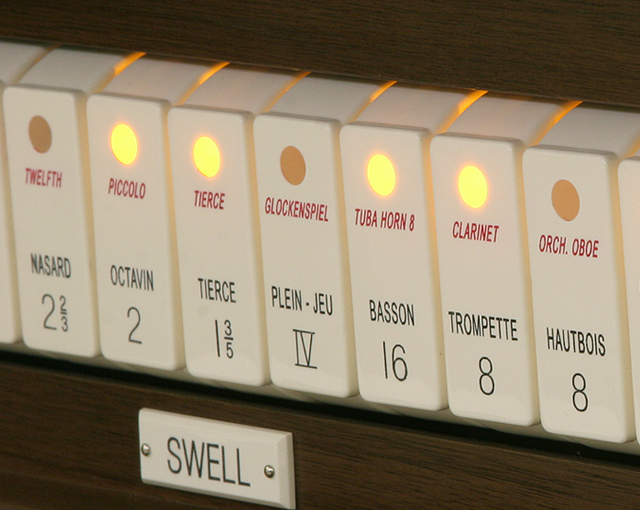
Allen designs and builds its own controls to provide the highest quality at affordable prices. From state-of-the-art Lumitech™ stops with advanced LED's to moving drawknobs, every control choice reflects Allen's uncompromising standards that ensure years of maintenance-free service.
The HISTORIQUE IIIG, 34 Stop, Two-manual organ is equipped with Allen's efficient LED stop controls.
HISTORIQUE IIIG STOP LIST
Standard stop lists: Classic Allen, English, Cavaillé-Coll, Schlicker, Arp Schnitger, Aeolian-Skinner, Wurlitzer, Barton, Morton
PEDAL
16 BOURDON
16 BOURDON DOUX (SW)
8 OCTAVE
8 GEDACKTFLÖTE
4 CHORAL BASS
MIXTURE IV
16 POSAUNE
4 CLARION
GENISYS VOICE 1 (OPTIONAL)
GENISYS VOICE 2 (OPTIONAL)
GREAT TO PEDAL
SWELL TO PEDAL
POSITIV TO PEDAL
BASS COUPLER
SWELL
8 GEDACKT
8 SALICIONAL
8 VOIX CELESTE
4 PRINCIPAL
4 TRAVERS-FLÖTE
2-2/3 NASAT
2 BLOCKFLÖTE
1-3/5 TIERCE
MIXTURE IV
16 BASSON
8 TROMPETTE
GENISYS VOICE 3 (OPTIONAL)
GENISYS VOICE 4 (OPTIONAL)
TREMULANT
GREAT
16 LIEBLICH GEDACKT (SW)
8 PRINCIPAL
8 HARMONIC FLUTE
4 OCTAVE
4 SPITZFLÖTE
2 SUPER OCTAVE
MIXTURE IV
8 TROMPETTE
GENISYS VOICE 5 (OPTIONAL)
GENISYS VOICE 6 (OPTIONAL)
TREMULANT
SWELL TO GREAT
POSITIV TO GREAT
ALTERNATE TUNING
GT-PD UNENCLOSED
POSITIV
8 HOLZ GEDACKT
4 PRINZIPAL
4 KOPPELFLÖTE
2 OKTAVE
1 1/3 QUINTFLÖTE
MIXTURE II
8 KRUMMHORN
GENISYS VOICE 7 (OPTIONAL)
GENISYS VOICE 8 (OPTIONAL)
TREMULANT
SWELL TO POSITIV
GENISYS VOICES COUPLE
MIDI
MIDI ON PEDAL
MIDI ON SWELL
MIDI ON GREAT
MIDI ON POSITIV
From the multiple stop list versatility to the distinct sounds available in all ALLEN organs, each stop list is independently voiced with its own audio settings.
CLASSIC ALLEN
The "signature" specification that made Allen the world's favorite organ! Allen tonal directors created the specifications of Allen digital organs by selecting their favorite samples from fine pipe organs throughout the world.
ENGLISH (mainly Willis samples)
Characterized by Diapasons and weighty reeds, this style of organ building was brought to its height by renowned 19th-century British organ craftsman Henry Willis.
CAVAILLÉ-COLL/French Romantic
Progenitor and master of the 19th-century French style with fiery and dominant reeds; symphonic tonal schemes.
SCHLICKER/Neo-Baroque
Neo-Baroque scalings by The Schlicker Organ Company; 20th-century revival of 17th-century North German ideals.
ARP SCHNITGER
Master German builder who brought the bright, incisive Werkprinzip style to its zenith.
AEOLIAN-SKINNER
Under the tonal direction of G. Donald Harrison, this company developed the American Classic tonal design, characterized by firm and articulate principals, bright mixtures and French-style reeds. Its versatility enables the American Classic to authentically perform a broad range of musical styles.
WURLITZER
"The Mighty Wurlitzer" was perhaps the "gold standard" of theatre organs during the silent movie era.
BARTON
Barton was mainly known in the Midwest area in the United States. Their most famous instrument was the theatre organ installed in the Chicago Stadium. Bartons were known for their "aggressive" voicing style.
MORTON
Morton theatre organs "evolved" over the course of the silent movie era. Our digital samples are from a late 1920s organ that used higher wind pressures than the typical theatre organ and was known as one of Morton's "jazzier" instruments.
HISTORIQUE IIG STOP LIST
Standard stop lists: Classic Allen, English, Cavaillé-Coll, Schlicker, Arp Schnitger, Aeolian-Skinner, Wurlitzer, Barton, Morton
PEDAL
16 BOURDON
16 LIEBLICH GEDACKT (SW)
8 OCTAVE
8 GEDACKTFLÖTE
4 CHORAL BASS
MIXTURE IV
16 POSAUNE
4 CLARION
GENISYS VOICE 1 (OPTIONAL)
GENISYS VOICE 2 (OPTIONAL)
GREAT TO PEDAL
SWELL TO PEDAL
SWELL
8 GEDACKT
8 SALICIONAL
8 VOIX CELESTE
4 PRINCIPAL
4 TRAVERS-FLÖTE
2-2/3 NASAT
2 BLOCKFLÖTE
1-3/5 TIERCE
MIXTURE IV
16 BASSON
8 TROMPETTE
GENISYS VOICE 3 (OPTIONAL)
GENISYS VOICE 4 (OPTIONAL)
TREMULANT
GREAT
16 LIEBLICH GEDACKT (SW)
8 PRINCIPAL
8 HARMONIC FLUTE
8 FLUTE CELESTE II
4 OCTAVE
4 SPITZFLÖTE
2 SUPER OCTAVE
MIXTURE IV
8 KRUMMHORN
GENISYS VOICE 5 (OPTIONAL)
GENISYS VOICE 6 (OPTIONAL)
TREMULANT
SWELL TO GREAT
BASS COUPLER
ALTERNATE TUNING
GT-PD UNENCLOSED
GENISYS VOICES COUPLE
MIDI
MIDI ON PEDAL
MIDI ON SWELL
MIDI ON GREAT
From the multiple stop list versatility to the distinct sounds available in all ALLEN organs, each stop list is independently voiced with its own audio settings.
CLASSIC ALLEN
The "signature" specification that made Allen the world's favorite organ! Allen tonal directors created the specifications of Allen digital organs by selecting their favorite samples from fine pipe organs throughout the world.
ENGLISH (mainly Willis samples)
Characterized by Diapasons and weighty reeds, this style of organ building was brought to its height by renowned 19th-century British organ craftsman Henry Willis.
CAVAILLÉ-COLL/French Romantic
Progenitor and master of the 19th-century French style with fiery and dominant reeds; symphonic tonal schemes.
SCHLICKER/Neo-Baroque
Neo-Baroque scalings by The Schlicker Organ Company; 20th-century revival of 17th-century North German ideals.
ARP SCHNITGER
Master German builder who brought the bright, incisive Werkprinzip style to its zenith.
AEOLIAN-SKINNER
Under the tonal direction of G. Donald Harrison, this company developed the American Classic tonal design, characterized by firm and articulate principals, bright mixtures and French-style reeds. Its versatility enables the American Classic to authentically perform a broad range of musical styles.
WURLITZER
"The Mighty Wurlitzer" was perhaps the "gold standard" of theatre organs during the silent movie era.
BARTON
Barton was mainly known in the Midwest area in the United States. Their most famous instrument was the theatre organ installed in the Chicago Stadium. Bartons were known for their "aggressive" voicing style.
MORTON
Morton theatre organs "evolved" over the course of the silent movie era. Our digital samples are from a late 1920s organ that used higher wind pressures than the typical theatre organ and was known as one of Morton's "jazzier" instruments.

Allen designs and builds its own controls to provide the highest quality at affordable prices. From state-of-the-art Lumitech™ stops with advanced LED's to moving drawknobs, every control choice reflects Allen's uncompromising standards that ensure years of maintenance-free service.
The HISTORIQUE IIG, 28 Stop, Two-manual organ is equipped with Allen's efficient LED stop controls.

Allen designs and builds its own controls to provide the highest quality at affordable prices. From state-of-the-art Lumitech™ stops with advanced LED's to moving drawknobs, every control choice reflects Allen's uncompromising standards that ensure years of maintenance-free service.
The HISTORIQUE Ia, 24 Stop, Two-manual organ is equipped with Allen's efficient LED stop controls.

STANDARD KEYBOARDS
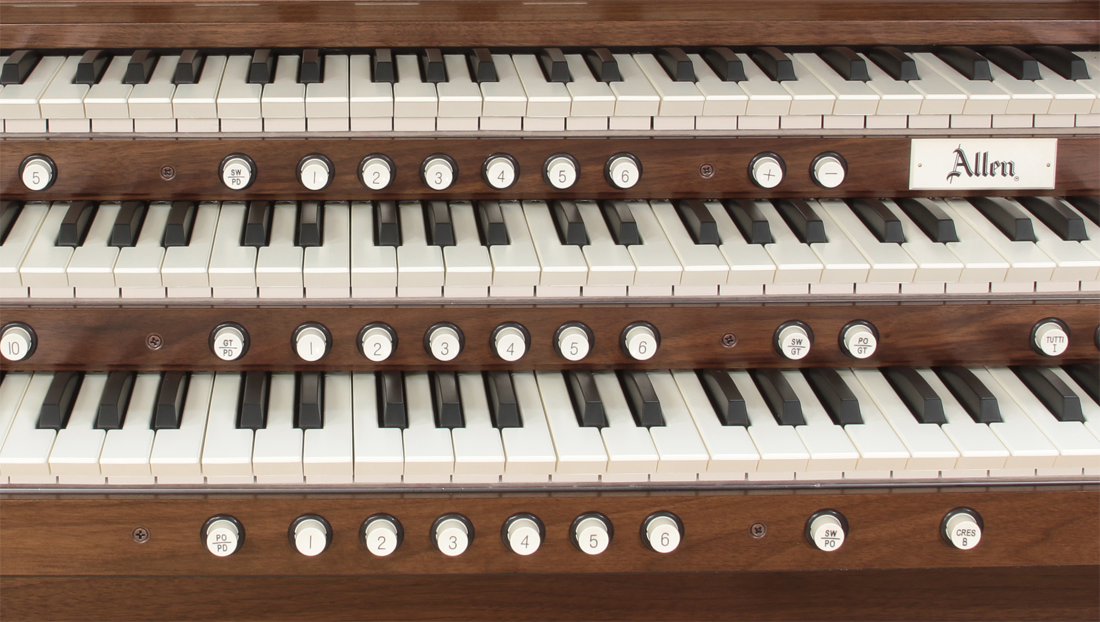
PREMIUM KEYBOARDS


HISTORIQUE customers can choose from two different compact pedalboards: a standard 32-Note Compact Radiating Pedalboard, or the optional 32-Note Parallel Pedalboard. Watch the Pedalboard Comparison video to see which one is right for you!

ALLEN EXPRESSION / CRESCENDO PEDALS

EXPRESSION SHOE CAGE

STANDARD KEYBOARDS

HISTORIQUE customers can choose from two different compact pedalboards: a standard 32-Note Compact Radiating Pedalboard, or the optional 32-Note Parallel Pedalboard. Watch the Pedalboard Comparison video to see which one is right for you!

HISTORIQUE Ia STOP LIST
Standard stop lists: Classic Allen, English, French, Baroque, Wurlitzer
PEDAL
16 BOURDON
16 LIEBLICH GEDACKT (SW)
8 OCTAVE
8 GEDACKTFLÖTE
4 CHORAL BASS
16 POSAUNE
4 CLARION
GREAT TO PEDAL
SWELL TO PEDAL
SWELL
8 GEDACKT
8 SALICIONAL
8 VOIX CELESTE
4 PRINCIPAL
4 KOPPELFLÖTE
2-2/3 NASAT
2 BLOCKFLÖTE
1-3/5 TIERCE
MIXTURE IV
8 TROMPETTE
TREMULANT
GREAT
8 PRINCIPAL
8 HARMONIC FLUTE
4 OCTAVE
4 SPITZFLÖTE
2 SUPER OCTAVE
MIXTURE IV
8 KRUMMHORN
TREMULANT
SWELL TO GREAT
MIDI
MIDI ON PEDAL
MIDI ON SWELL
MIDI ON GREAT
From the multiple stop list versatility to the distinct sounds available in all ALLEN organs, each stop list is independently voiced with its own audio settings.
CLASSIC ALLEN
The "signature" specification that made Allen the world's favorite organ! Allen tonal directors created the specifications of Allen digital organs by selecting their favorite samples from fine pipe organs throughout the world.
ENGLISH (mainly Willis samples)
Characterized by Diapasons and weighty reeds, this style of organ building was brought to its height by renowned 19th-century British organ craftsman Henry Willis.
FRENCH
19th-century French style with fiery and dominant reeds; symphonic tonal schemes.
BAROQUE
20th-century revival of 17th-century North German ideals.
WURLITZER
"The Mighty Wurlitzer" was perhaps the "gold standard" of theatre organs during the silent movie era.
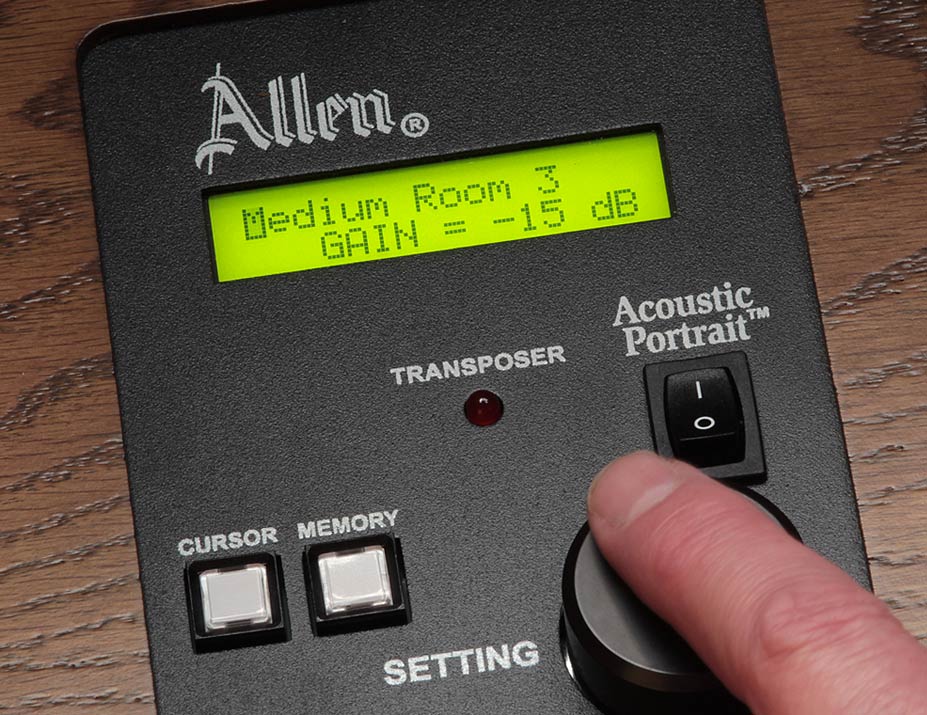
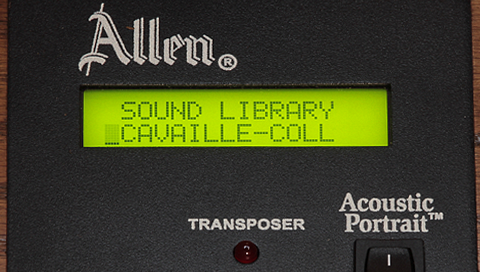
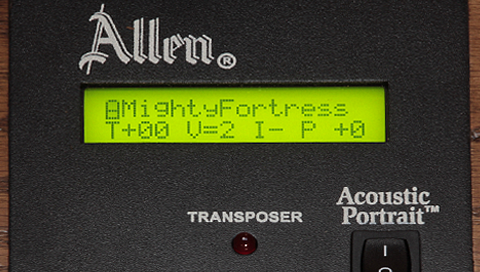
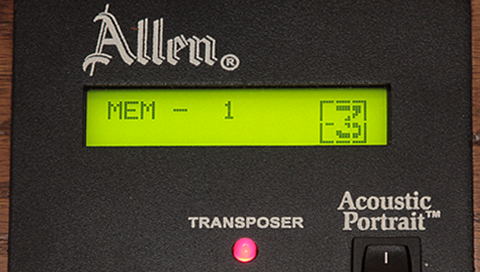

Allen designs and builds its own controls to provide the highest quality at affordable prices. From state-of-the-art Lumitech™ stops with advanced LED's to moving drawknobs, every control choice reflects Allen's uncompromising standards that ensure years of maintenance-free service.
The R-10, 28 Stop, Two-manual organ is equipped with Allen's efficient LED stop controls.
R-10 STOP LIST
Standard stop lists: Classic Allen, English, French, Baroque, Wurlitzer
PEDAL
16 BOURDON
16 LIEBLICH GEDACKT (SW)
8 OCTAVE
8 FLÛTE
4 CHORAL BASS (GT)
16 POSAUNE
4 CLAIRON
GREAT TO PEDAL
SWELL TO PEDAL
SWELL
8 GEDACKT
8 VIOLA POMPOSA
8 VIOLA CELESTE
4 OCTAVE GEIGEN
4 TRAVERSE FLUTE
2-2/3 NASARD
2 PICCOLO
1-3/5 TIERCE
FOURNITURE IV
16 BASSON
8 TROMPETTE
TREMULANT
GREAT
16 LIEBLICH GEDACKT (SW)
8 DIAPASON
8 HARMONIC FLUTE
8 FLUTE CELESTE II
4 OCTAVE
4 SPITZFLÖTE
2 FIFTEENTH
MIXTURE IV
8 KRUMMHORN
CHIMES
TREMULANT
SWELL TO GREAT
GENERAL
ALTERNATE TUNING
BASS COUPLER
MELODY COUPLER
TREMULANTS FULL
MIDI
MIDI ON PEDAL
MIDI ON SWELL
MIDI ON GREAT
From the multiple stop list versatility to the distinct sounds available in all ALLEN organs, each stop list is independently voiced with its own audio settings.
CLASSIC ALLEN
The "signature" specification that made Allen the world's favorite organ! Allen tonal directors created the specifications of Allen digital organs by selecting their favorite samples from fine pipe organs throughout the world.
ENGLISH (mainly Willis samples)
Characterized by Diapasons and weighty reeds, this style of organ building was brought to its height by renowned 19th-century British organ craftsman Henry Willis.
FRENCH
19th-century French style with fiery and dominant reeds; symphonic tonal schemes.
BAROQUE
20th-century revival of 17th-century North German ideals.
WURLITZER
"The Mighty Wurlitzer" was perhaps the "gold standard" of theatre organs during the silent movie era.
A digital church organ is a unique product utilizing modern technology to reproduce an art form whose heritage comes from pipe organs.
Superior sound comes from a combination of greater experience sampling pipe organs and advanced sound-producing technology. Experience matters! Allen introduced the world's first digitally sampled organ in 1971, nearly two decades prior to its nearest competitor. Allen's current GENISYS™ technology includes up to 48 advanced DSP's (Digital Signal Processors) working in parallel; supercomputer power for superior sound production. And Allen organs can be voiced to perfection to any school of organ design!

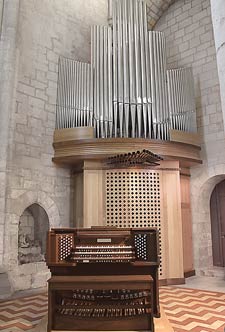
Today, the preference for Allen sound extends even beyond the realm of digital organ customers to pipe organ owners. Notably, Allen is chosen as the organ builder of choice to add digital voices and advanced consoles to hundreds of pipe organs throughout the world, including prestigious European installations. With unmatched tonal quality and sophisticated technology, Allen is pleased to help preserve and advance an important art form. It's why we exist.

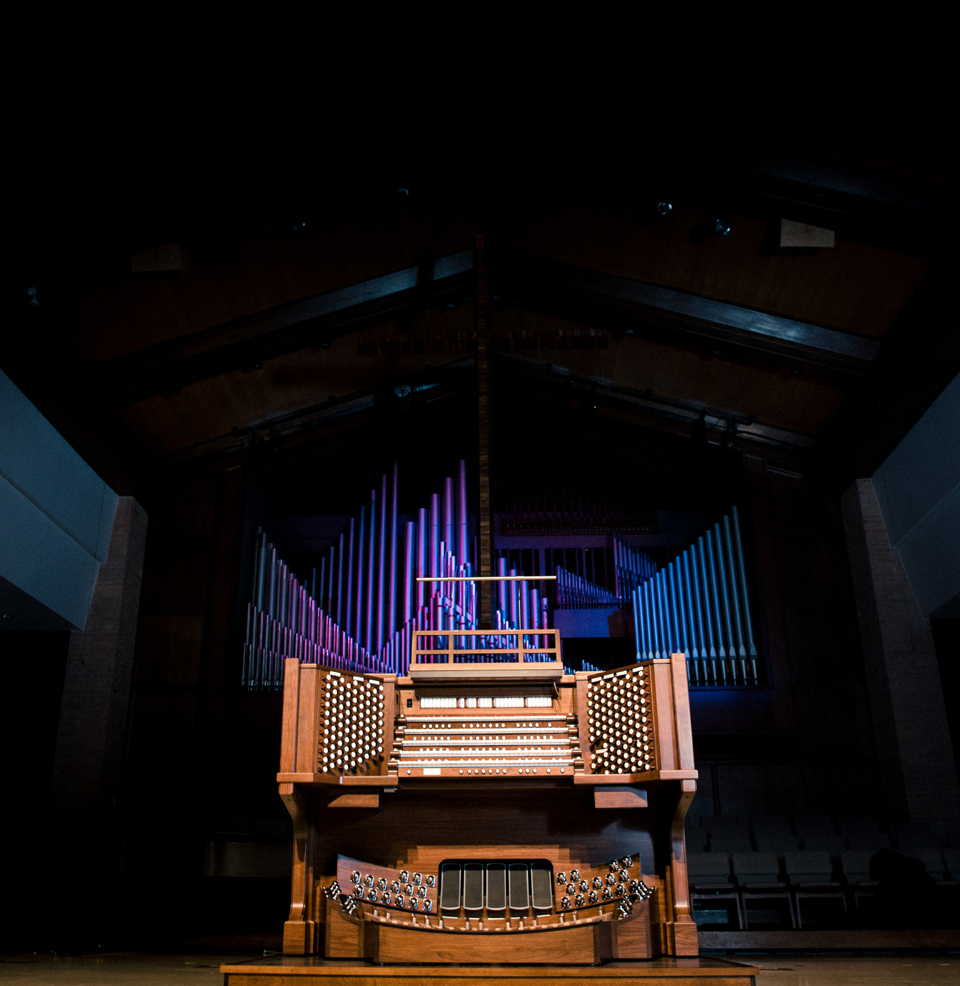
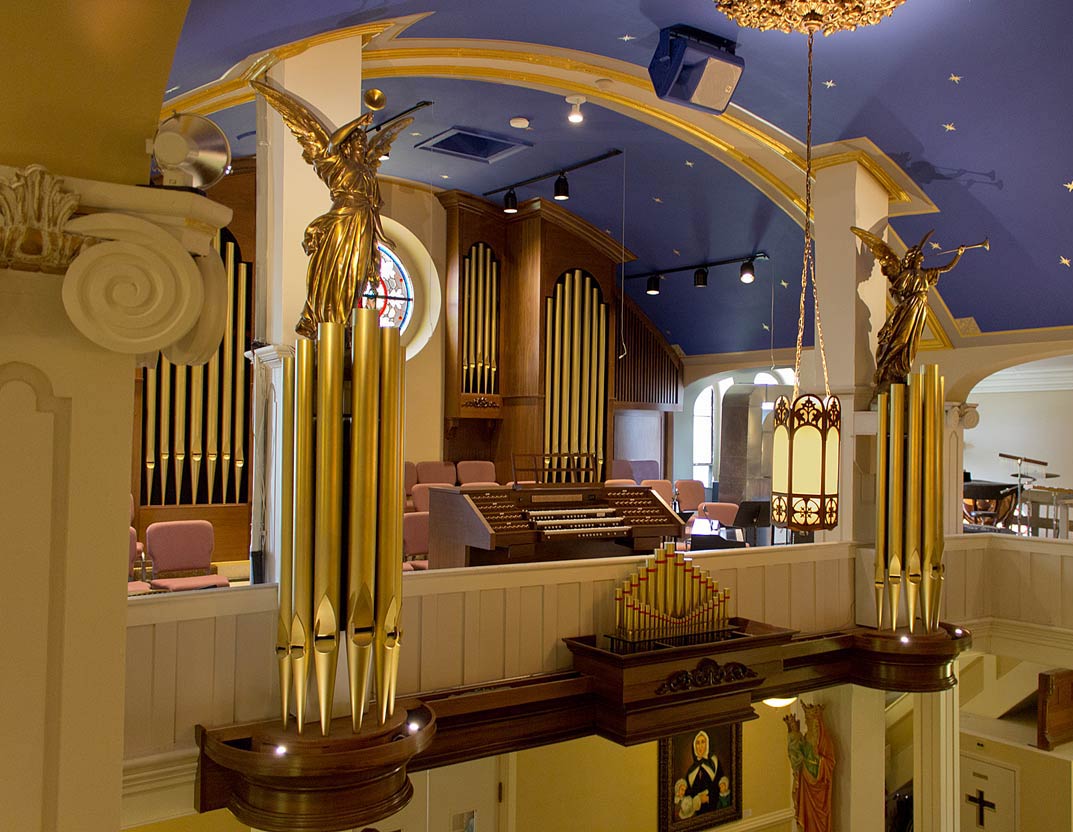

ALLEN EXPRESSION / CRESCENDO PEDALS
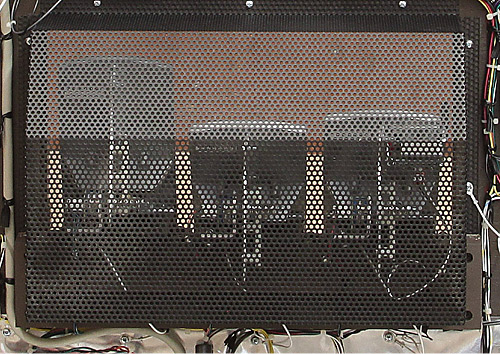
EXPRESSION SHOE CAGE
G100 STOP LIST
Standard stop lists: Classic Allen, English, Cavaillé-Coll, Schlicker, Arp Schnitger, Aeolian-Skinner, Wurlitzer, Barton, Morton
PEDAL
16 BOURDON
16 LIEBLICH BOURDON (SW)
8 OCTAVE
8 FLUTE
4 SUPER OCTAVE (GT)
MIXTURE IV
16 BOMBARDE
4 CLARION
GENISYS VOICE 1 (OPTIONAL)
GENISYS VOICE 2 (OPTIONAL)
GREAT TO PEDAL
SWELL TO PEDAL
SWELL
8 GEDACKT
8 VIOLE
8 VOIX CELESTE
4 OCTAVE GEIGEN
4 TRAVERSE FLUTE
2-2/3 NASARD
2 PICCOLO
1-3/5 TIERCE
PLEIN JEU IV
16 BASSON
8 TROMPETTE
TREMULANT
GENISYS VOICE 3 (OPTIONAL)
GENISYS VOICE 4 (OPTIONAL)
GREAT
16 LIEBLICH GEDACKT (SW)
8 PRINCIPAL
8 HARMONIC FLUTE
8 FLUTE CELESTE II (SW)
4 OCTAVE
4 FLUTE
2 FIFTEENTH
MIXTURE IV
8 KRUMMHORN
TREMULANT
CHIMES
GENISYS VOICE 5 (OPTIONAL)
GENISYS VOICE 6 (OPTIONAL)
SWELL TO GREAT
GENERAL
BASS COUPLER
MELODY COUPLER
ALTERNATE TUNING
TREMULANTS FULL
GENISYS VOICES COUPLE
MIDI
MIDI ON PEDAL
MIDI ON SWELL
MIDI ON GREAT
From the multiple stop list versatility to the distinct sounds available in all ALLEN organs, each stop list is independently voiced with its own audio settings.
CLASSIC ALLEN
The "signature" specification that made Allen the world's favorite organ! Allen tonal directors created the specifications of Allen digital organs by selecting their favorite samples from fine pipe organs throughout the world.
ENGLISH (mainly Willis samples)
Characterized by Diapasons and weighty reeds, this style of organ building was brought to its height by renowned 19th-century British organ craftsman Henry Willis.
CAVAILLÉ-COLL/French Romantic
Progenitor and master of the 19th-century French style with fiery and dominant reeds; symphonic tonal schemes.
SCHLICKER/Neo-Baroque
Neo-Baroque scalings by The Schlicker Organ Company; 20th-century revival of 17th-century North German ideals.
ARP SCHNITGER
Master German builder who brought the bright, incisive Werkprinzip style to its zenith.
AEOLIAN-SKINNER
Under the tonal direction of G. Donald Harrison, this company developed the American Classic tonal design, characterized by firm and articulate principals, bright mixtures and French-style reeds. Its versatility enables the American Classic to authentically perform a broad range of musical styles.
WURLITZER
"The Mighty Wurlitzer" was perhaps the "gold standard" of theatre organs during the silent movie era.
BARTON
Barton was mainly known in the Midwest area in the United States. Their most famous instrument was the theatre organ installed in the Chicago Stadium. Bartons were known for their "aggressive" voicing style.
MORTON
Morton theatre organs "evolved" over the course of the silent movie era. Our digital samples are from a late 1920s organ that used higher wind pressures than the typical theatre organ and was known as one of Morton's "jazzier" instruments.
GX-215a STOP LIST
Standard stop lists: Classic Allen, English, Cavaillé-Coll, Schlicker, Arp Schnitger, Aeolian-Skinner, Wurlitzer, Barton, Morton
PEDAL
32 CONTRA VIOLONE
16 PRINCIPAL
16 BOURDON
16 LIEBLICH BOURDON (SW)
8 OCTAVE
8 FLUTE
4 SUPER OCTAVE
MIXTURE IV
16 BOMBARDE
4 CLARION
GENISYS VOICE 1 (OPTIONAL)
GENISYS VOICE 2 (OPTIONAL)
GREAT TO PEDAL
SWELL TO PEDAL
SWELL
8 ROHR BOURDON
8 VIOLE
8 VOIX CELESTE
4 GEIGEN OCTAVE
4 TRAVERSE FLUTE
2-2/3 NASARD
2 PICCOLO
1-3/5 TIERCE
PLEIN JEU IV
16 BASSON
8 TROMPETTE
8 HAUTBOIS
TREMULANT
CELESTA
SWELL UNISON OFF
GENISYS VOICE 3 (OPTIONAL)
GENISYS VOICE 4 (OPTIONAL)
GREAT
16 VIOLONE
8 PRINCIPAL
8 HARMONIC FLUTE
8 FLUTE DOLCE CELESTE II (SW)
4 OCTAVE
4 FLUTE
2 FIFTEENTH
MIXTURE IV
8 TRUMPET
8 KRUMMHORN
TREMULANT
CHIMES
GENISYS VOICE 5 (OPTIONAL)
GENISYS VOICE 6 (OPTIONAL)
SWELL TO GREAT
GENERAL
BASS COUPLER
MELODY COUPLER
ALTERNATE TUNING
TREMULANTS FULL
GENISYS VOICES COUPLE
EXTERNAL SPEAKERS OFF
CONSOLE SPEAKERS OFF
MIDI
MIDI ON PEDAL
MIDI ON SWELL
MIDI ON GREAT
From the multiple stop list versatility to the distinct sounds available in all ALLEN organs, each stop list is independently voiced with its own audio settings.
CLASSIC ALLEN
The "signature" specification that made Allen the world's favorite organ! Allen tonal directors created the specifications of Allen digital organs by selecting their favorite samples from fine pipe organs throughout the world.
ENGLISH (mainly Willis samples)
Characterized by Diapasons and weighty reeds, this style of organ building was brought to its height by renowned 19th-century British organ craftsman Henry Willis.
CAVAILLÉ-COLL/French Romantic
Progenitor and master of the 19th-century French style with fiery and dominant reeds; symphonic tonal schemes.
SCHLICKER/Neo-Baroque
Neo-Baroque scalings by The Schlicker Organ Company; 20th-century revival of 17th-century North German ideals.
ARP SCHNITGER
Master German builder who brought the bright, incisive Werkprinzip style to its zenith.
AEOLIAN-SKINNER
Under the tonal direction of G. Donald Harrison, this company developed the American Classic tonal design, characterized by firm and articulate principals, bright mixtures and French-style reeds. Its versatility enables the American Classic to authentically perform a broad range of musical styles.
WURLITZER
"The Mighty Wurlitzer" was perhaps the "gold standard" of theatre organs during the silent movie era.
BARTON
Barton was mainly known in the Midwest area in the United States. Their most famous instrument was the theatre organ installed in the Chicago Stadium. Bartons were known for their "aggressive" voicing style.
MORTON
Morton theatre organs "evolved" over the course of the silent movie era. Our digital samples are from a late 1920s organ that used higher wind pressures than the typical theatre organ and was known as one of Morton's "jazzier" instruments.
GX-236 STOP LIST
Standard stop lists: Classic Allen, English, Cavaillé-Coll, Schlicker, Arp Schnitger, Aeolian-Skinner, Wurlitzer, Barton, Morton
PEDAL
32 CONTRA VIOLONE
16 DIAPASON
16 BOURDON
16 BOURDON DOUX (SW)
16 VIOLONE
8 OCTAVE
8 GEDACKT
4 CHORAL BASS
MIXTURE IV
16 BOMBARDE
8 TROMPETTE
4 CLARION
GENISYS VOICE 1 (OPTIONAL)
GENISYS VOICE 2 (OPTIONAL)
SWELL
8 GEIGEN DIAPASON
8 ROHR BOURDON
8 SALICIONAL
8 VOIX CELESTE
4 PRESTANT
4 FLÛTE
2-2/3 NASARD
2 OCTAVIN
1-3/5 TIERCE
PLEIN-JEU IV
16 BASSON
8 FESTIVAL TRUMPET (NC)
8 TROMPETTE
8 HAUTBOIS
TREMULANT
CELESTA
UNISON OFF
GENISYS VOICE 3 (OPTIONAL)
GENISYS VOICE 4 (OPTIONAL)
GREAT
16 VIOLONE
8 DIAPASON
8 GEMSHORN
8 HARMONIC FLUTE
8 FLUTE DOLCE CELESTE II
4 OCTAVE
4 SPIRE FLUTE
2 FIFTEENTH
MIXTURE IV
CYMBALE III
9 FESTIVAL TRUMPET (NC)
8 TROMBA
8 KRUMMHORN
TREMULANT
CELESTA (SW)
CHIMES
GENISYS VOICE 5 (OPTIONAL)
GENISYS VOICE 6 (OPTIONAL)
COUPLERS
8 GREAT TO PEDAL
8 SWELL TO PEDAL
8 SWELL TO GREAT
MELODY COUPLER
BASS COUPLER
GENISYS VOICES COUPLE
GENERAL
ALTERNATE TUNING
TREMULANTS FULL
ANTIPHONAL
SWELL MAINS OFF
SWELL TO ANTIPHONAL
GT-PD MAINS OFF
GT-PD TO ANTIPHONAL
MIDI
MIDI ON PEDAL
MIDI ON SWELL
MIDI ON GREA
From the multiple stop list versatility to the distinct sounds available in all ALLEN organs, each stop list is independently voiced with its own audio settings.
CLASSIC ALLEN
The "signature" specification that made Allen the world's favorite organ! Allen tonal directors created the specifications of Allen digital organs by selecting their favorite samples from fine pipe organs throughout the world.
ENGLISH (mainly Willis samples)
Characterized by Diapasons and weighty reeds, this style of organ building was brought to its height by renowned 19th-century British organ craftsman Henry Willis.
CAVAILLÉ-COLL/French Romantic
Progenitor and master of the 19th-century French style with fiery and dominant reeds; symphonic tonal schemes.
SCHLICKER/Neo-Baroque
Neo-Baroque scalings by The Schlicker Organ Company; 20th-century revival of 17th-century North German ideals.
ARP SCHNITGER
Master German builder who brought the bright, incisive Werkprinzip style to its zenith.
AEOLIAN-SKINNER
Under the tonal direction of G. Donald Harrison, this company developed the American Classic tonal design, characterized by firm and articulate principals, bright mixtures and French-style reeds. Its versatility enables the American Classic to authentically perform a broad range of musical styles.
WURLITZER
"The Mighty Wurlitzer" was perhaps the "gold standard" of theatre organs during the silent movie era.
BARTON
Barton was mainly known in the Midwest area in the United States. Their most famous instrument was the theatre organ installed in the Chicago Stadium. Bartons were known for their "aggressive" voicing style.
MORTON
Morton theatre organs "evolved" over the course of the silent movie era. Our digital samples are from a late 1920s organ that used higher wind pressures than the typical theatre organ and was known as one of Morton's "jazzier" instruments.
GX-342 STOP LIST
Standard stop lists: Classic Allen, English, Cavaillé-Coll, Schlicker, Arp Schnitger, Aeolian-Skinner, Wurlitzer, Barton, Morton
PEDAL
32 CONTRA VIOLONE
16 DIAPASON
16 BOURDON
16 BOURDON DOUX (SW)
16 ERZÄHLER (CH)
8 OCTAVE
8 GEDACKT
4 CHORAL BASS
MIXTURE IV
32 CONTRE BOMBARDE
16 BOMBARDE
16 BASSON (SW)
8 TROMPETTE
4 CLARION
GENISYS VOICE 1 (OPTIONAL)
GENISYS VOICE 2 (OPTIONAL)
SWELL
16 BOURDON DOUX
8 GEIGEN DIAPASON
8 ROHR BOURDON
8 SALICIONAL
8 VOIX CELESTE
4 PRESTANT
4 FLÛTE
2-2/3 NASARD
2 OCTAVIN
1-3/5 TIERCE
PLEIN JEU IV
16 BASSON
8 TROMPETTE
8 HAUTBOIS
8 VOX HUMANA
4 CLAIRON
TREMULANT
UNISON OFF
GENISYS VOICE 3 (OPTIONAL)
GENISYS VOICE 4 (OPTIONAL)
GREAT
16 BOURDON DOUX (SW)
8 DIAPASON
8 HARMONIC FLUTE
8 FLUTE CELESTE II
8 VIOLE
4 OCTAVE
4 SPIRE FLUTE
2 FIFTEENTH
MIXTURE IV
8 TROMPETE
TREMULANT
CHIMES
GT-PD UNENCLOSED
GENISYS VOICE 5 (OPTIONAL)
GENISYS VOICE 6 (OPTIONAL)
CHOIR
16 ERZÄHLER
8 PRINCIPAL
8 HOLZ GEDACKT
8 ERZÄHLER
8 ERZÄHLER CELESTE
4 OCTAVE
4 KOPPELFLÖTE
2 SUPER OCTAVE
1-1/3 QUINTFLÖTE
MIXTURE III
8 FESTIVAL TRUMPET
8 KRUMMHORN
TREMULANT
UNISON OFF
GT-CH MANUAL TRANSFER
CHOIR EXPRESS W/SWELL
GENISYS VOICE 7 (OPTIONAL)
GENISYS VOICE 8 (OPTIONAL)
COUPLERS
8 GREAT TO PEDAL
8 SWELL TO PEDAL
8 CHOIR TO PEDAL
8 SWELL TO GREAT
8 CHOIR TO GREAT
8 SWELL TO CHOIR
MELODY COUPLER CH>GT
BASS COUPLER
GENISYS VOICES COUPLE
GENERAL
ALTERNATE TUNING
TREMULANTS FULL
ANTIPHONAL
SWELL MAINS OFF
SWELL TO ANTIPHONAL
GT-CH-PD MAINS OFF
GT-CH-PD TO ANTIPHONAL
MIDI
MIDI ON PEDAL
MIDI ON SWELL
MIDI ON GREAT
MIDI ON CHOIR
From the multiple stop list versatility to the distinct sounds available in all ALLEN organs, each stop list is independently voiced with its own audio settings.
CLASSIC ALLEN
The "signature" specification that made Allen the world's favorite organ! Allen tonal directors created the specifications of Allen digital organs by selecting their favorite samples from fine pipe organs throughout the world.
ENGLISH (mainly Willis samples)
Characterized by Diapasons and weighty reeds, this style of organ building was brought to its height by renowned 19th-century British organ craftsman Henry Willis.
CAVAILLÉ-COLL/French Romantic
Progenitor and master of the 19th-century French style with fiery and dominant reeds; symphonic tonal schemes.
SCHLICKER/Neo-Baroque
Neo-Baroque scalings by The Schlicker Organ Company; 20th-century revival of 17th-century North German ideals.
ARP SCHNITGER
Master German builder who brought the bright, incisive Werkprinzip style to its zenith.
AEOLIAN-SKINNER
Under the tonal direction of G. Donald Harrison, this company developed the American Classic tonal design, characterized by firm and articulate principals, bright mixtures and French-style reeds. Its versatility enables the American Classic to authentically perform a broad range of musical styles.
WURLITZER
"The Mighty Wurlitzer" was perhaps the "gold standard" of theatre organs during the silent movie era.
BARTON
Barton was mainly known in the Midwest area in the United States. Their most famous instrument was the theatre organ installed in the Chicago Stadium. Bartons were known for their "aggressive" voicing style.
MORTON
Morton theatre organs "evolved" over the course of the silent movie era. Our digital samples are from a late 1920s organ that used higher wind pressures than the typical theatre organ and was known as one of Morton's "jazzier" instruments.
GX-336 STOP LIST
Standard stop lists: Classic Allen, English, Cavaillé-Coll, Schlicker, Arp Schnitger, Aeolian-Skinner, Wurlitzer, Barton, Morton
PEDAL
32 CONTRA VIOLONE
16 DIAPASON
16 BOURDON
16 BOURDON DOUX (SW)
16 VIOLONE
8 OCTAVE
8 GEDACKT
4 CHORAL BASS
MIXTURE IV
16 BOMBARDE
8 TROMPETTE
4 CLARION
GENISYS VOICE 1 (OPTIONAL)
GENISYS VOICE 2 (OPTIONAL)
SWELL
8 GEIGEN DIAPASON
8 ROHR BOURDON
8 SALICIONAL
8 VOIX CELESTE
4 PRESTANT
4 FLÛTE
2-2/3 NASARD
2 OCTAVIN
1-3/5 TIERCE
PLEIN-JEU IV
16 BASSON
8 TROMPETTE
8 HAUTBOIS
TREMULANT
GENISYS VOICE 3 (OPTIONAL)
GENISYS VOICE 4 (OPTIONAL)
GREAT
16 VIOLONE
8 DIAPASON
8 GEMSHORN
8 HARMONIC FLUTE
8 FLUTE CELESTE II
4 OCTAVE
4 SPIRE FLUTE
2 FIFTEENTH
MIXTURE IV
8 TRUMPET
CHIMES
TREMULANT
GENISYS VOICE 5 (OPTIONAL)
GENISYS VOICE 6 (OPTIONAL)
CHOIR
8 PRINCIPAL
8 COR DE NUIT
4 OCTAVE
4 NACHTHORN
2 BLOCKFLÖTE
1-1/3 LARIGOT
CYMBEL III
8 CLARINET
TREMULANT
CHOIR UNENCLOSED
GT-CH MANUAL TRANSFER
GENISYS VOICE 7 (OPTIONAL)
GENISYS VOICE 8 (OPTIONAL)
COUPLERS
8 GREAT TO PEDAL
8 SWELL TO PEDAL
8 CHOIR TO PEDAL
8 SWELL TO GREAT
8 CHOIR TO GREAT
8 SWELL TO CHOIR
MELODY COUPLER CH>GT
BASS COUPLER
GENISYS VOICES COUPLE
GENERAL
ALTERNATE TUNING
TREMULANTS FULL
ANTIPHONAL
MAIN ORGAN OFF
ANTIPHONAL ORGAN ON
MIDI
MIDI ON PEDAL
MIDI ON SWELL
MIDI ON GREAT
MIDI ON CHOIR
From the multiple stop list versatility to the distinct sounds available in all ALLEN organs, each stop list is independently voiced with its own audio settings.
CLASSIC ALLEN
The "signature" specification that made Allen the world's favorite organ! Allen tonal directors created the specifications of Allen digital organs by selecting their favorite samples from fine pipe organs throughout the world.
ENGLISH (mainly Willis samples)
Characterized by Diapasons and weighty reeds, this style of organ building was brought to its height by renowned 19th-century British organ craftsman Henry Willis.
CAVAILLÉ-COLL/French Romantic
Progenitor and master of the 19th-century French style with fiery and dominant reeds; symphonic tonal schemes.
SCHLICKER/Neo-Baroque
Neo-Baroque scalings by The Schlicker Organ Company; 20th-century revival of 17th-century North German ideals.
ARP SCHNITGER
Master German builder who brought the bright, incisive Werkprinzip style to its zenith.
AEOLIAN-SKINNER
Under the tonal direction of G. Donald Harrison, this company developed the American Classic tonal design, characterized by firm and articulate principals, bright mixtures and French-style reeds. Its versatility enables the American Classic to authentically perform a broad range of musical styles.
WURLITZER
"The Mighty Wurlitzer" was perhaps the "gold standard" of theatre organs during the silent movie era.
BARTON
Barton was mainly known in the Midwest area in the United States. Their most famous instrument was the theatre organ installed in the Chicago Stadium. Bartons were known for their "aggressive" voicing style.
MORTON
Morton theatre organs "evolved" over the course of the silent movie era. Our digital samples are from a late 1920s organ that used higher wind pressures than the typical theatre organ and was known as one of Morton's "jazzier" instruments.
| ||||||||||||||||||||||||||||||||||||||||
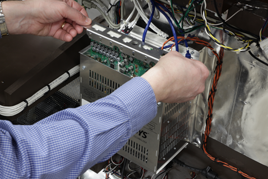
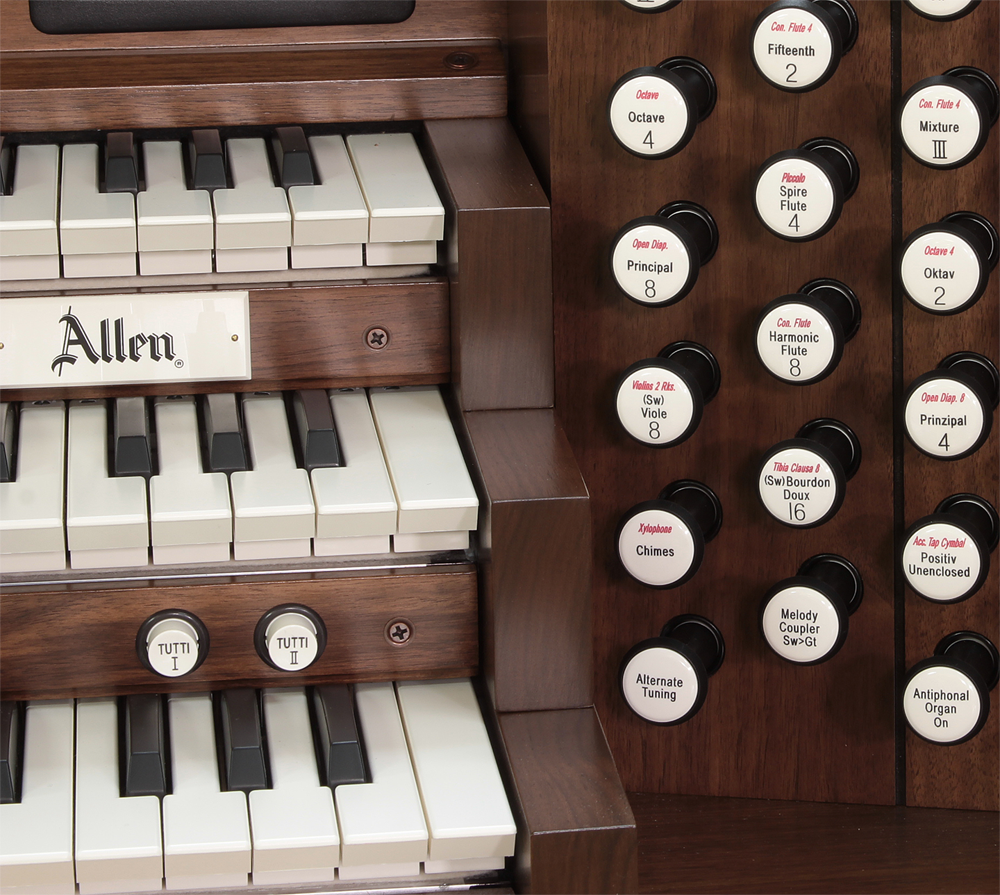
ALLEN'S CONSTRUCTION QUALITY
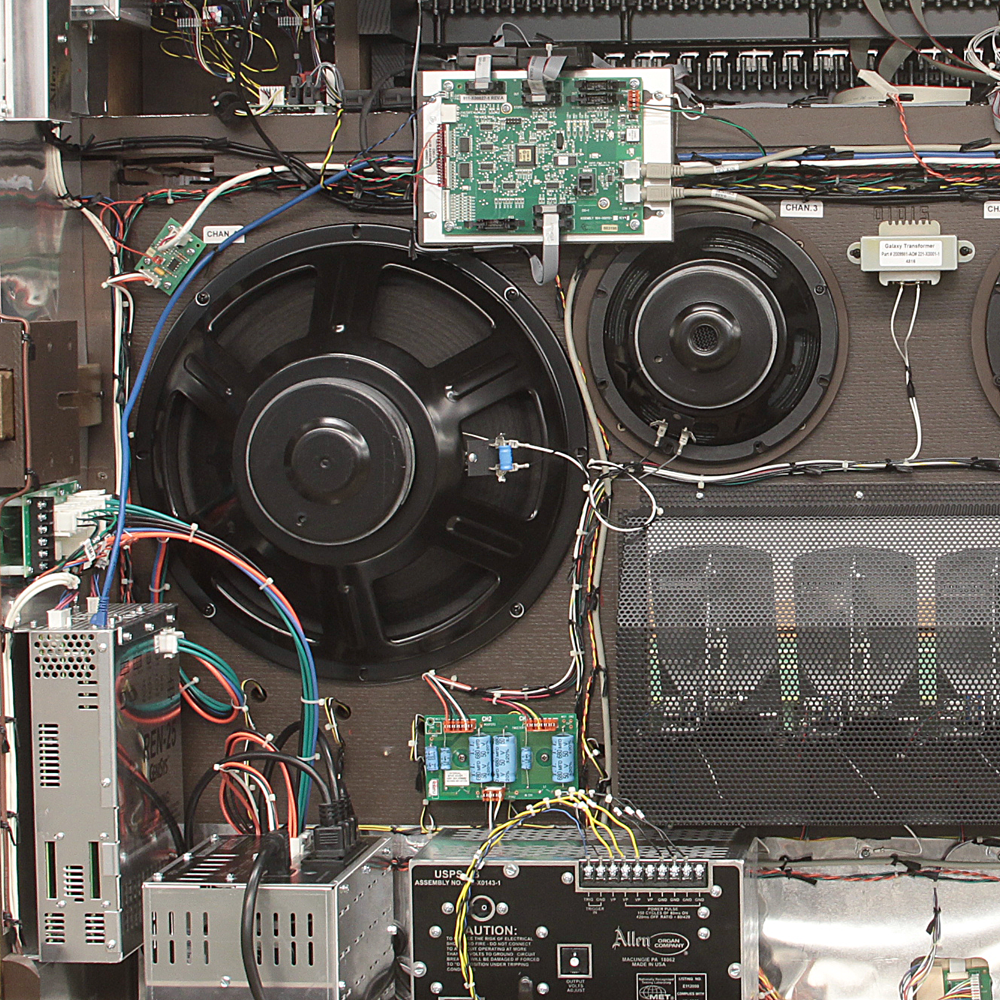
OUR ORGAN INTERIOR
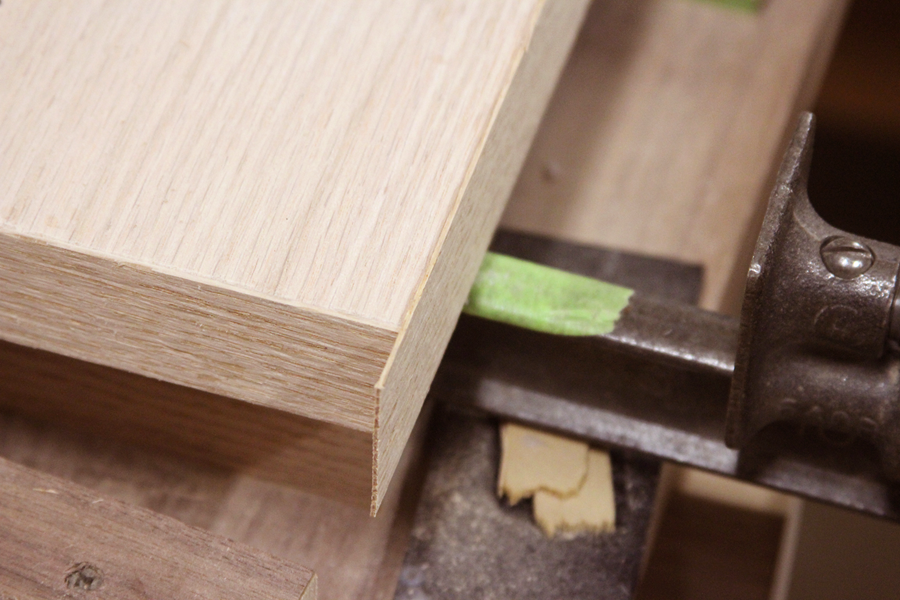

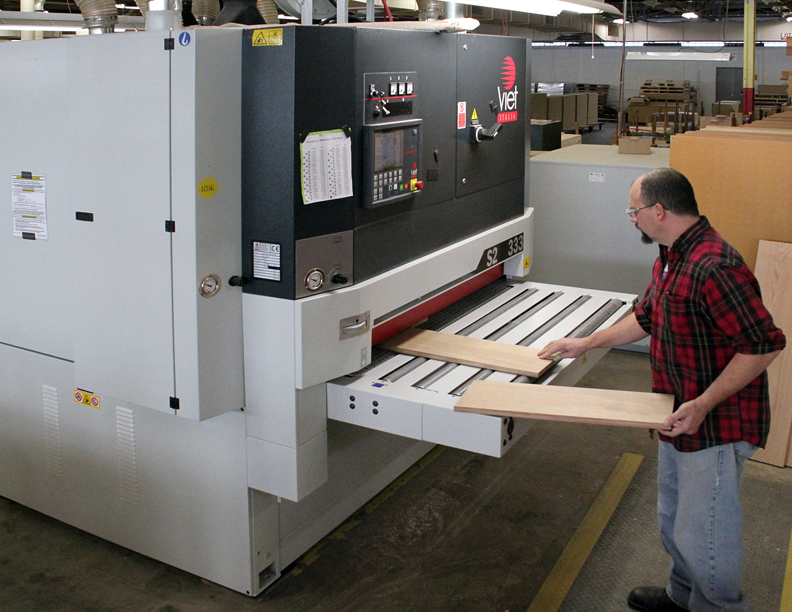
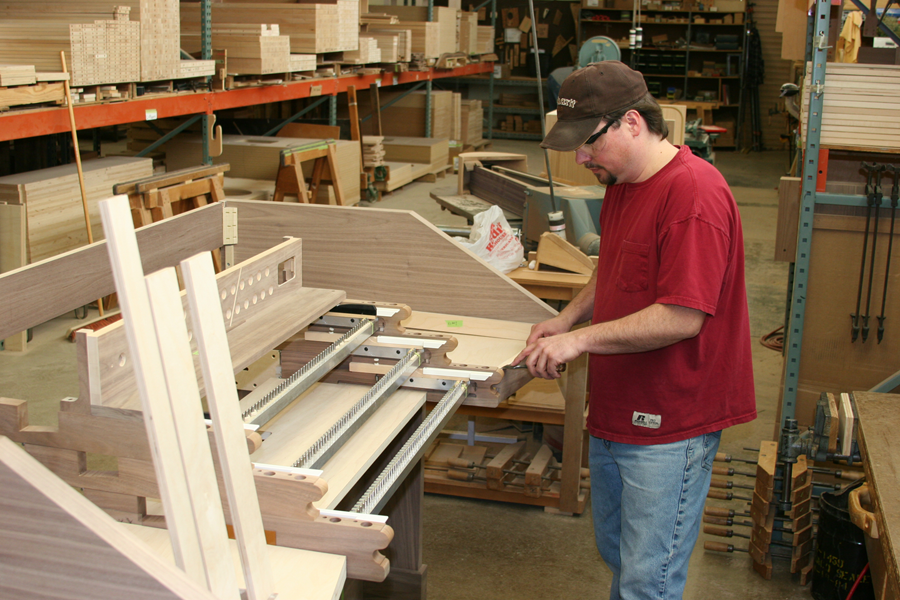

ALLEN EXPRESSION / CRESCENDO PEDALS

EXPRESSION SHOE CAGE
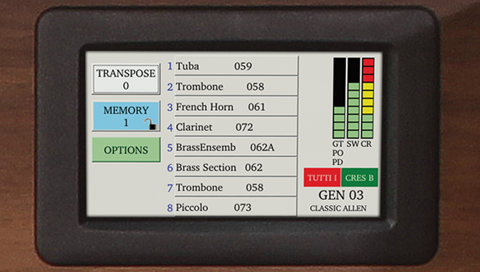
"Simplicity is the ultimate sophisticaton."
Leonardo da Vinci

ThIs model can be customized to suit your personal and church organ requirements. Just ask!
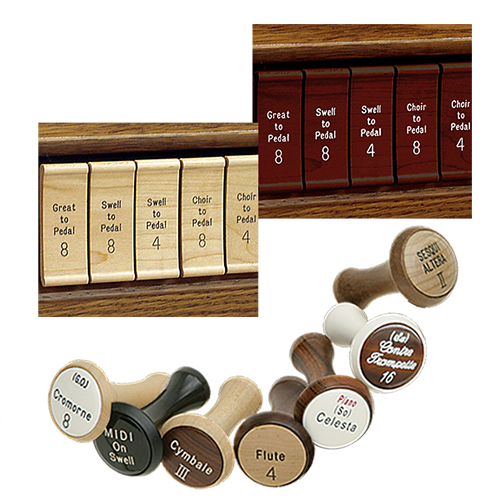
Allen designs and builds its own controls to provide the highest quality at affordable prices. From state-of-the-art Lumitech™ stops with advanced LED's to moving drawknobs, every control choice reflects Allen's uncompromising standards that ensure years of maintenance-free service.




STANDARD KEYBOARDS

PREMIUM KEYBOARDS
The Allen keyboard utilizes sealed contacts and wood keysticks to provide the ultimate in touch and control. The level of quality and adjustability of Allen keyboards makes them the envy of the industry and the choice of discerning musicians.
KEY CONTACT
The key contact, while unseen, is an important part of any church organ. If one fails during a performance, the entire musical program can be compromised. Allen introduced a maintenance-free system in which a sealed reed switch is engaged by magnet. Neither dust nor the environment will compromise your music program with an Allen Organ.


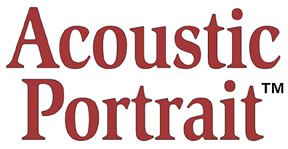
Dry, crisp acoustics designed to make spoken words easy to understand can make music sound brittle and uninteresting. Organ sound, especially, comes alive in more resonant spaces. Most organs include obsolete digital reverb, to artificially imitate acoustics. But not Allen. Allen's revolutionary Acoustic Portrait™ produces the "real thing"!
Based on a remarkable technology called convolution, Acoustic Portrait realistically recreates the "sonic fingerprint" of actual rooms ranging from small churches to large, famous cathedrals. Don't let the acoustics of your room stand between you and beautiful music-making. Acoustic Portrait will add the dimension you've been missing.
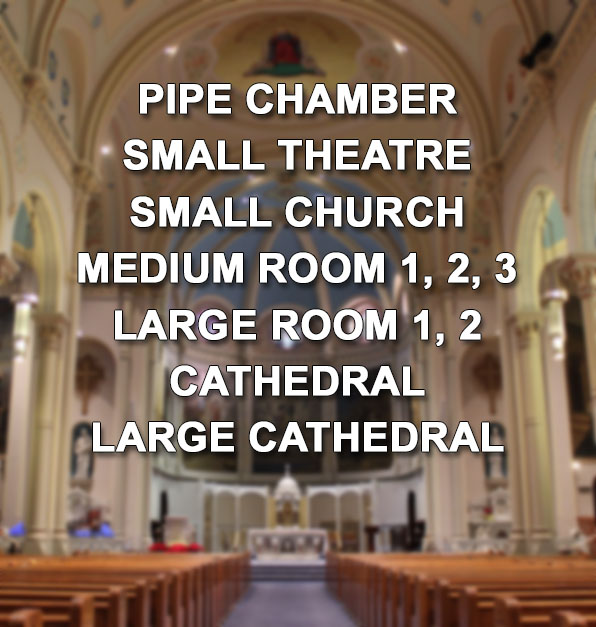
GX-350a STOP LIST
Standard stop lists: Classic Allen, English, Cavaillé-Coll, Schlicker, Arp Schnitger, Aeolian-Skinner
PEDAL
32 CONTRA VIOLONE
16 DIAPASON
16 BOURDON
16 BOURDON DOUX (SW)
16 VIOLONE (GT)
8 OCTAVE
8 GEDACKT FLÖTE
4 CHORAL BASS
4 FLUTE
MIXTURE IV
32 CONTRE BOMBARDE
16 BOMBARDE
16 CONTRE TROMPETTE (SW)
8 TRUMPET
4 CLARION
GENISYS VOICE 1 (OPTIONAL)
GENISYS VOICE 2 (OPTIONAL)
SWELL
8 GEIGEN DIAPASON
8 ROHR BOURDON
8 FLUTE CELESTE II
8 VIOLA POMPOSA
8 VIOLA CELESTE
4 OCTAVE GEIGEN
4 TRAVERSE FLUTE
2-2/3 NASARD [4 ORCH. FLUTE]
2 PICCOLO [8 CLARINET]
1-3/5 TIERCE [8 FRENCH HORN]
FOURNITURE IV
16 CONTRE TROMPETTE
8 TROMPETTE
8 OBOE
8 VOX HUMANA [COR ANGLAIS]
4 CLAIRON
CELESTA
16 SWELL
UNISON OFF
4 SWELL
TREMULANT
SWELL SOLO VOICES ON
GENISYS VOICE 3 (OPTIONAL)
GENISYS VOICE 4 (OPTIONAL)
GREAT
16 VIOLONE
8 DIAPASON
8 HARMONIC FLUTE
8 BOURDON
8 GAMBA
4 OCTAVE
4 FLUTE
2-2/3 TWELFTH
2 FIFTEENTH
MIXTURE IV
CYMBALE III
8 TROMBA
CHIMES
TREMULANT
GT-PD UNENCLOSED
GENISYS VOICE 5 (OPTIONAL)
GENISYS VOICE 6 (OPTIONAL)
CHOIR
16 ERZÄHLER
8 PRINCIPAL
8 HOLZ GEDACKT
8 ERZÄHLER
8 ERZÄHLER CELESTE
4 OCTAVE
4 KOPPELFLÖTE
4 ERZÄHLER CELESTE II
2 SUPER OCTAVE
1-1/3 QUINTFLÖTE
MIXTURE III
8 FESTIVAL TRUMPET
8 KRUMMHORN
TREMULANT
UNISON OFF
CHOIR UNENCLOSED
GT-CH MANUAL TRANSFER
GENISYS VOICE 7 (OPTIONAL)
GENISYS VOICE 8 (OPTIONAL)
COUPLERS
8 GREAT TO PEDAL
8 SWELL TO PEDAL
4 SWELL TO PEDAL
8 CHOIR TO PEDAL
16 SWELL TO GREAT
8 SWELL TO GREAT
4 SWELL TO GREAT
8 CHOIR TO GREAT
16 SWELL TO CHOIR
8 SWELL TO CHOIR
4 SWELL TO CHOIR
MELODY COUPLER CH>GT
BASS COUPLER
GENISYS VOICES COUPLE
GENERAL
ALTERNATE TUNING
TREMULANTS FULL
ANTIPHONAL
SWELL MAINS OFF
SWELL TO ANTIPHONAL
GT-CH-PD MAINS OFF
GT-CH-PD TO ANTIPHONAL
MIDI
MIDI ON PEDAL
MIDI ON SWELL
MIDI ON GREAT
MIDI ON CHOIR
From the multiple stop list versatility to the distinct sounds available in all ALLEN organs, each stop list is independently voiced with its own audio settings.
CLASSIC ALLEN
The "signature" specification that made Allen the world's favorite organ! Allen tonal directors created the specifications of Allen digital organs by selecting their favorite samples from fine pipe organs throughout the world.
ENGLISH (mainly Willis samples)
Characterized by Diapasons and weighty reeds, this style of organ building was brought to its height by renowned 19th-century British organ craftsman Henry Willis.
CAVAILLÉ-COLL/French Romantic
Progenitor and master of the 19th-century French style with fiery and dominant reeds; symphonic tonal schemes.
SCHLICKER/Neo-Baroque
Neo-Baroque scalings by The Schlicker Organ Company; 20th-century revival of 17th-century North German ideals.
ARP SCHNITGER
Master German builder who brought the bright, incisive Werkprinzip style to its zenith.
AEOLIAN-SKINNER
Under the tonal direction of G. Donald Harrison, this company developed the American Classic tonal design, characterized by firm and articulate principals, bright mixtures and French-style reeds. Its versatility enables the American Classic to authentically perform a broad range of musical styles.

GENISYS™ Voices provide the tonal diversity of a comprehensive stop list to even the most modest instruments. GENISYS Voices set a new standard for organist-friendly operation and include sounds that enhance every style of worship and organ literature!